Fume Extraction Guns: Understanding the Basics
New industry standards from the Occupational Safety and Health Administration (OSHA) are protecting employees against potential health hazards in the workplace. These regulations, which dictate allowable exposure limits of welding fumes and other particulates (including hexavalent chromium), have led many companies to invest in fume extraction equipment. An increased desire to maintain optimal welding operator safety and to attract new skilled welding operators to the field is also a consideration in investing in this equipment — companies want to create the most comfortable and healthy work environment possible.
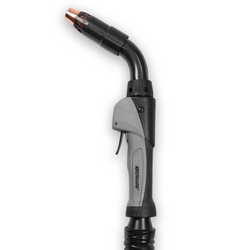
Some companies may opt for centralized fume extraction systems, which are designed to protect the entire shop area. These systems involve the installation of new ductwork
Fume extraction guns are available in a variety of amperages, cable styles and handle designs. As with any welding equipment, they have their advantages and limitations, best applications, maintenance requirements and more. In combination with many other variables in the welding operation — welding wire selection, specific transfer methods and welding processes, welding operator behavior and base material selection — fume extraction guns can help companies maintain compliance with safety regulations and create a cleaner, more comfortable welding environment.
The basics of fume extraction guns
Fume extraction guns operate by capturing the fume generated by the welding process right at the source, over and around the weld pool. Various manufacturers have proprietary means of constructing guns to conduct this action, but at a basic level they all operate similarly: by mass flow, or the movement of material. This movement occurs by way of a vacuum chamber that suctions the fumes through the handle of the gun, into the gun’s hose through to a port on the filtration system (sometimes informally referred to as a vacuum box).
The welding fumes that these guns remove are composed of a combination of the filler metal and base material. Some fume extraction guns feature adjustable extraction control regulators at the front of the gun handle, which allow welding operators to increase suction as needed (without affecting shielding gas coverage), while others provide this function internally. Regardless of the manner, the ability to balance between the downward flow of shielding gas and the upward flow of the suctioned air is critical. The fume extraction gun needs to provide the appropriate amount of shielding gas to protect the weld from defects such as porosity, without sacrificing the ability to suction fumes efficiently enough to protect the welding operator. The balance allows the weld pool time to react and solidify, and gives the fume particles time to decelerate so they are easier to extract.
Typically, fume extraction guns are larger than regular welding guns and tend to be bulky due to the vacuum and hose necessary to extract the fumes. For that reason, some manufacturers create fume extraction guns with a vacuum hose swivel on the rear of the handle to make them easier to maneuver. Manufacturers have also, since fume extraction guns were first introduced (in the late 1960s and early 1970s), found ways to engineer internal components to minimize the handle weight in order to reduce operator fatigue.
Applications, advantages and limitations
Fume extraction guns are well-suited for applications using solid welding wire and those in confined spaces. These include, but are not limited to applications in the shipbuilding and heavy equipment manufacturing industries, as well as general manufacturing and fabrication. They are also ideal for welding on stainless steel applications, as this material generates greater levels of hexavalent chromium, and on mild and carbon steel applications. The guns also work well on high amperage and high deposition rate applications and are available, typically, in 300 to 600 amp ranges.
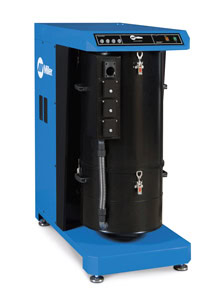
For the best results, fume extraction guns should be used for in-position welding, such as on flat butt welds. In this position, they can most effectively capture fume particles as they rise from the weld pool. In out-of-position welds, the energy of the fume particles causes them to rise at a high rate, making it more difficult for the fume extraction gun to draw them downward and through the vacuum hose.
One distinct advantage to fume extraction guns is that they remove the fumes at the source. This will minimize the amount that enters the welding operator’s immediate breathing zone. However, because welding operators typically move the gun away from the weld pool after completing a pass, the fume extraction gun is not as able to control residual fume as well as a fume extraction hood can.
Maintenance tips
As with any piece of welding equipment, fume extraction guns benefit from preventive maintenance. Caring for them is similar to caring for a standard GMAW gun. Regularly check for tight connections throughout the length of the fume extraction gun to ensure good electrical flow. Minimizing electrical resistance helps ensure consistent weld quality and prevent premature failure of the front-end consumables — contact tip, nozzle and diffuser.
Frequently inspect the nozzle and contact tip for signs of spatter build-up, too, as such build-up can obstruct shielding gas flow and cause weld defects that ultimately will need to be reworked. Spatter build-up can also cause consumables to fail prematurely. Replace the consumables if spatter build-up appears or clean them according to the manufacturer’s recommendation. In some cases the shroud that surrounds the nozzle may also have to be replaced or cleaned free of spatter.
To ensure optimal fume extraction capabilities, inspect the vacuum hose regularly for damage, including cuts or kinks that could lead to loss of suction. Replace a damaged vacuum hose as necessary and dispose of it according to the manufacturer’s and/or an industrial hygienist’s directions.
Visually inspect the handle for cracks or missing screws, and also check that the gun’s trigger is not sticking or otherwise malfunctioning. Replace or repair these components as necessary.
Finally, maintenance on the liner is also important. As with the vacuum hose, use compressed air to clear out any potential blockages during welding wire changeovers or when removing the wire from the gun. Spending an extra few minutes clearing out any debris from the liner can save considerably more time than troubleshooting the weld defects and equipment problems that can result from blockages. Also, track the amount of time that it takes for a liner to wear during the course of the welding operation. Replace the liner prior to that in the future to prevent downtime for replacement during shifts or problems with wire feeding or quality.
When in doubt about maintenance or any other aspect of using a fume extraction gun, consider working with a trusted welding distributor, certified industrial hygienist and/or the fume extraction gun manufacturer to address any questions or concerns. Proper use of this equipment can help provide optimal results, and improve the safety and comfort of the welding environment.
In the fabrication and manufacturing world, quality and productivity are everything. To remain competitive, companies need to look continually for ways to increase throughput and minimize defects, while also keeping costs low for parts and labor. In many cases, turning to robotic welding is a means to achieve those goals — for both the smaller job shop and larger manufacturing facilities. The decision to implement a robotic weld cell, however, takes a good deal of consideration and planning if the system is to function in the most efficient, productive and profitable manner. And it requires a significant investment. Fortunately, the long-term benefits of a robotic welding operation can be very positive. For companies who have already invested in robotic welding, but are looking to improve or better understand their operations, or for those considering the investment, it is critical to consider some key factors about the technology. Here, we will explore “what you must know about robotic welding” to make the most of the process. Justifying the cost of a robotic weld cell comes down to the ability to gain (and prove) a payback on the investment. Typically, that payback comes in the form of greater productivity and higher-quality welds (which minimize instances of costly and time-consuming rework), but there are other contributing factors to the return on the investment (ROI) in this technology. Robotic welding also offers the advantage of lower energy and labor costs, and in many cases lower material costs due to fewer instances of overwelding. Overwelding is a common and costly occurrence in semi-automatic welding. A weld bead that is 1/8-inch larger than necessary can double filler metal costs, but a robot can reduce those costs by only putting down as much material as necessary. Plus, robotic welding systems use bulk filler metals (600-pound drums, for example) that companies can often purchase at a greater discount. For companies just considering the investment in robotic welding, it is important to consider how to calculate the payback. Assess the current part cycle times and compare those to the potential cycle times of a robot. A trusted robotic welding integrator or OEM can often help with this calculation. During this process, also consider the possibility of reallocating existing labor to other parts of the welding operation, where these individuals can add value to the process. Remember, up to 75 percent of the cost in a semi-automatic welding operation is labor. If there is the opportunity to use that labor elsewhere to increase part production, the payback on the investment in robotic welding will increase. Most companies — particularly smaller ones or those with frequent production changes — seek a payback on the robotic welding investment of no greater than 12 to 15 months. That time frame is entirely possible to achieve with proper up-front planning of the part blueprints, fixturing and general setup of the system. In some cases, companies may be able to justify a longer payback period if they know that their production needs will remain relatively static for longer periods of time. The output from a robotic welding cell is only as good as the parts fed into it. In order to gain the advantages of these systems, it is critical to have accurate, repeatable part designs. Gaps, poor fit-up or poor joint access all prevent a robot from completing its job correctly. The best part designs for a robotic welding application are simple ones that allow the robot to execute the same weld repeatedly. High-volume applications with low-variety parts are especially poised to gain the advantages of robotic welding. Companies should try to avoid part designs that require intricate tooling or clamping to hold it in place, as both can hinder the efficiency of the robot and also add to the up-front cost of the operation. That said, in some cases, companies may still be able to gain a good payback on the investment in tooling for slightly more complex parts, but they will need to weigh out the pros and cons of that cost ahead of time. Companies also need to be certain to assess their overall welding operation for consistent process flow. Bottlenecks upstream can easily slow down the movement of parts into the robotic work cell and the ability of the system to function to its full capacity. A robot that sits idle costs time and money. Some companies may need to reconfigure operations or set up a flexible cell that can manage quick tool and fixture changes in order to minimize bottlenecks in the process flow. It is also important to have adequate labor to supply the robot with parts. Again, companies should consider tapping the knowledge of a robotic welding integrator for advice and assistance to optimize process flow. The robotic MIG gun and consumables on a robot together are responsible for directing the current to the arc to complete the weld, making them integral components in the whole system. To gain the best quality and to avoid expensive downtime for maintenance, repairs or replacement, companies need to select a robotic MIG gun that is suitable for the amperage, duty cycle and cooling capacity needed in the application. Using a robotic MIG gun that offers inadequate cooling or amperage can cause performance issues and lead to premature failure — both factors that increase costs and downtime. Likewise, using a robotic MIG gun that offers higher amperages than necessary raises the total cost of ownership, as typically the cost of a robotic MIG gun increases directly in proportion to its amperage. Companies also need to select their consumables — contact tips, nozzles, retaining heads (diffusers) and liners — carefully and manage them properly in order to gain optimal productivity and lower costs. Look for contact tips with more mass at the front end and that are buried further in the gas diffuser — both features help the tip resist heat from the arc. Consumables with tapered connections mate securely together to provide good electrical conductivity, which also reduces heat buildup and helps the consumables last longer. Contact tips with long tails and coarse threads are also a good option to simplify installation — they virtually eliminate cross-threading because the tail concentrically aligns the contact tip within the diffuser before the threads engage. This easy-to-install design works well for operations with less experienced welding operators who may not be as familiar with consumable changeovers. It also helps reduce unplanned downtime for troubleshooting associated with cross-threading. As with robotic MIG guns, carefully matching the type of consumables to the application can keep companies from having to address premature failures and/or accrue costly downtime (not to mention, lapses in production). It can also keep them from overpaying for consumables that may be too much for the application. Companies should also consider the mode of welding when selecting consumables, as technology such as Pulsed welding tends to be especially harsh on consumables and often requires heavy-duty options to withstand the heat of the arc for longer periods of time. For these applications, look for contact tips that are engineered with a hardened insert, making them more resistant to arc erosion and wear. They typically last 10 times longer than copper or chrome zirconium tips. Companies can regain as much as 95% of lost productivity for contact tip changes with this style by reducing planned downtime for the task. Peripherals refer to any additional equipment integrated into the robotic welding system to maximize its performance. They include items such as a nozzle cleaning station (sometimes called a reamer or spatter cleaner), anti-spatter sprayers, wire cutters and neck alignment tools. Unfortunately, some companies downplay the value of peripherals, viewing them as an unnecessary cost, and don’t realize that they can play an important role in reducing downtime and rework, improving quality and increasing productivity. Consider a nozzle cleaning station, for example. As its name implies, this peripheral cleans the nozzle of dirt, debris and spatter, typically during routine pauses in the robotic welding operation. This cleaning action helps prevent shielding gas coverage loss that could lead to weld defects, expensive rework and lost productivity. The equipment also helps the front-end consumables last longer — and longer consumable life means less downtime for changeover and less expense for replacements. The addition of an anti-spatter sprayer further improves consumable life and performance by adding an anti-spatter compound that serves as a protective barrier against spatter buildup and other contaminants. In the long run, the up-front investment in peripherals such as these can lead to measurable savings and provide a better return on investment by aiding the robot in doing what it does best: complete consistent, high-quality welds for longer periods of time than a semi-automatic welding operation. Robotic welding operations require ongoing supervision and maintenance, and that job needs to be completed by a skilled operator who has undergone the proper training. When considering an investment in robotic welding, companies should take care to evaluate the available pool of talent. As a rule, skilled welding operators and/or employees with prior robotic welding experience are the best candidates to supervise the weld cell. After the proper training, which a robotic integrator or OEM can typically provide, these employees can provide the necessary operating and troubleshooting skills to ensure the maximum uptime in the robotic welding cell. As part of the routine training, it is absolutely necessary for the operators who will be overseeing the robot to be able to schedule and perform routine preventive maintenance on the system. Implementing preventive maintenance helps minimize unnecessary downtime and keep the robotic welding system running more smoothly. If problems can be solved before they arise and the robotic welding equipment made to last longer, it can protect the company’s investment, and ensure the productivity and profitability sought by this equipment in the first place. Companies should consider vetting robotic welding integrators to determine the availability and costs associated with the training of personnel. Typically training lasts one to three weeks, depending on the certification level desired, and continuing tutorials are often available. In the end, careful planning, good equipment selection and proper training are all “must-knows” for managing a profitable and productive robotic welding operation. So whether a company is new to robotic welding or trying to improve an existing operation, knowing some key factors can go a long way in helping to gain a competitive edge and to make the most out of the investment.
The term “ergonomics” has become increasingly common in the workplace as companies strive to improve safety and efficiency among employees — whether in the office or on the plant floor. At its most basic level, ergonomics refers to the discipline or science of designing equipment and arranging the work environment for optimal worker comfort and productivity. Minimizing fatigue, reducing repetitive motion, and decreasing overall physical and mental stress are some of the key factors at the heart of it. For welding operators who spend their time maneuvering around difficult weld joints with a MIG, flux-cored or fume extraction welding gun and facing a hot arc, the term takes on an especially important meaning. A welding gun’s handle, neck and power cable design can significantly impact the duration of time a welding operator can weld without experiencing fatigue or stress. So too can the heat generated in the process. Excessive heat, just like musculoskeletal strain, can contribute negatively to the welding operator’s health and efficiency. In the long run, choosing a welding gun that offers greater comfort and operates at a cooler temperature can help increase productivity and, ultimately, the profitability of the welding operation by allowing for greater arc-on time. When welding, the first factor in good ergonomics is to select a welding gun with the appropriate handle design. Typically, manufacturers offer handles in curved and straight designs, one or the other of which may be more comfortable for a given welding operator to hold and control. The preference is individual and a welding operator may need to experiment to determine which design best suits him or her. If possible, a welding operator may want to consider using a slightly lower-amperage welding gun to gain greater comfort and minimize fatigue and/or stress on the wrists and hands. Typically, as a welding gun’s amperage decreases, so too does the size of the gun handle, which makes the equipment lighter and easier to maneuver for longer periods of time. It is important, however, that in selecting a smaller and lighter-weight handle, the welding operator still has a gun that meets the application’s amperage and duty cycle requirements. Duty cycle is defined by the amount of arc-on time in a 10-minute period that the equipment can be operated at maximum capacity. Some welding guns will offer 100 percent duty cycle, while others are rated 60 percent or below. In many cases, a welding gun rated at 300 amps, for example, may suffice for a 400-amp application considering that welding operators rarely weld continuously enough to exceed the gun’s duty cycle. In a shop setting, another option to gain greater comfort and productivity would be to convert to a water-cooled welding gun for MIG applications, as these guns are generally smaller, lighter and easier for welding operators to manage for longer periods of time. Smaller, shorter and lighter power cables offer greater flexibility to welding operators, making it easier to maneuver the equipment without excess stress on the wrists or hands. A good rule of thumb is to select the smallest and shortest power cable possible that can still meet the needs of the application. Smaller, shorter power cables can also minimize clutter in the weld cell by preventing excessive coiling and minimizing tripping hazards. Less clutter and coiling also reduces the chance of poor wire feeding that could cause downtime and hinder productivity. On fume extraction guns, look for vacuum hose swivel on rear of handle, as this feature improves flexibility and reduces welding operator fatigue. Many MIG and flux-cored guns are available with rotatable and flexible necks in various lengths and angles. These types of necks allow the welding operator to select one that will best suit the joint access required for an application. For example, rotatable necks are a good option for welding out of position, even overhead. They do not require the welding operator to change the welding gun handle or position, so he or she can hold the gun in a way that is most comfortable, while also gaining access to the weld joint. Similarly, flexible necks can be easily adjusted to fit different welding angles and reach difficult joints that may be restricted or otherwise awkward to reach. This feature also helps minimize straining to reach a particular weld joint, and with it reduces the opportunity for fatigue or injury. Some welding gun manufacturers also offer neck couplers. These accessories allow the welding operator to connect multiple necks together to reach especially difficult joints more comfortably. Increasing productivity in a welding operation by way of improved ergonomics is a matter of more than just having lightweight, easy-to-control equipment. It’s also a matter of minimizing heat stress in the work environment. When welding materials such as aluminum or stainless steel, there is an opportunity for greater radiant heat — heat that reflects from the welding arc and base metal back to the handle. Welding operators can use a longer neck on the welding gun to place the handle further back from the arc when welding on such applications. Also, the addition of a neck grip on a MIG gun can protect the welding operator from heat exposure and related fatigue. These high-temperature silicon rubber grips slide over the neck and offer the added benefit of increased control. They allow welding operators to rest the neck on their hand or forearm, using it as a pivot point to maneuver the MIG gun more comfortably. In the end, having equipment that is easy to operate during the welding process is the first step in achieving good ergonomics, a safe work environment and greater productivity. After all, a more comfortable welding operator is a more content one. And more content employees can help companies generate greater throughput on a day-to-day basis. Start the process by finding welding guns that are lightweight, offer an appropriate handle and neck design, and feature the right neck and power cable for the job and for the welding operator.
Employees at Jolson Welding work on tough structural pile and pipe welding projects and have come to rely on the durability and comfort of the Bernard Dura-Flux self-shielded flux-cored gun to increase productivity. “I like how the handle is shaped and how your hand fits around it. The gun contours your hand and glove, not cutting off the circulation to your fingers because of how they’re offset. The trigger guard isn’t too big to where your hands are hitting it or grabbing on everything. It’s just big enough to keep the trigger from getting hit and out of your way. This Bernard Dura-Flux gun’s got what they call a micro switch in it, so it’s a sealed switch. These are bulletproof. If you’re out in a dirty environment where laying on the ground all the time like ours it never gets any dirt or dust in it. It continues to work perfect all the time. The Centerfire is really nice because you don’t need tools to get the tip off.” Automated welding systems add speed, accuracy and repeatability to the welding operation. They can help operations increase productivity and reduce costs in a relatively short period of time. But these results don’t happen by accident; they require careful equipment selection, system integration and training — including the selection of peripherals. Peripherals refer to the additional equipment that is integrated into the automated welding system to maximize its performance. The selection and implementation of the proper peripherals should be a part of the welding automation plan upfront, not later after the system is in place. Incorporating peripherals early in the process can result in more efficient throughput, long-term cost savings, better quality welds and minimized downtime. Consider these frequently asked questions about peripherals to clarify their role in the welding operation and better understand their benefits. A nozzle cleaning station (also called a reamer) cleans spatter from the inside of the welding consumables on the front-end of the MIG welding gun, including nozzles, contact tips and retaining heads. There are several benefits a nozzle cleaning station can offer. First, by keeping the nozzle clean, this equipment helps reduce the risk of losing shielding gas coverage that could potentially lead to expensive re-work. Secondly, it helps lengthen the life of the consumables (nozzle, contact tip and diffuser or retaining head) and the robotic MIG gun. Longer equipment life translates into less downtime and also less cost for equipment — both factors that contribute positively to a company’s ROI of its automated welding system. An anti-spatter compound (typically in liquid form) can provide additional protection to consumables. A sprayer applies the anti-spatter compound to the front-end consumables after they have been cleaned. In many cases the sprayer can be mounted on the nozzle cleaning station, integrating it into the overall process of nozzle cleaning. Recall that the rule of “less is more” applies. Excessive anti-spatter usage can lead to unnecessary costs and the compound may build up on the nozzle, the welding robot and the parts being welded. In the long term, a high spray volume could cause additional problems that are just as harmful as spatter build-up itself. How can a wire cutter help the operation? Many robotic welding applications require consistent welding wire stick-out (also called electrode extension) when the arc initiates. A wire cutter can help maintain that consistency. As its name implies, a wire cutter cuts the welding wire to a specified length and it also removes any inconsistencies at the end of the wire, resulting in more reliable and smoother arc starts. For companies that program their robot to seam track (or find the joint) through touch sensing, the consistent wire stick-out allows for more reliable and repeatable welds by helping the robot to more easily locate the correct spot to begin welding. Most wire cutters are capable of cutting different types of welding wire, including stainless steel, flux-cored and metal-cored, usually up to 1/16-inch diameter. Companies may prefer to mount the wire cutter on a nozzle station or locate it remotely, according to their needs.?? This peripheral verifies that the robotic MIG gun’s neck is set to the intended tool center point (TCP), allowing it to be readjusted after a collision or if the neck becomes bent due to routine welding. Most inspection fixtures will accommodate standard necks for a particular brand of robotic gun. After determining the tolerances for the program, a trained welding operator simply adjusts the neck to meet the correct specifications. This adjustment helps prevent costly rework due to missing weld joints and can help prevent the downtime to reprogram the robot to meet the welding specifications with the existing bent neck. For companies that maintain a large number of robots, a neck inspection fixture can also help prevent confusion when exchanging necks from one robotic MIG gun to another. Welding operators simply remove a bent neck, exchange it with a spare that has already been inspected and adjusted, and put the robot back in service immediately. The damaged neck can then be set aside for inspection while the robot is still online. In cases where collision detection is integral to the robot, a solid arm mount can help protect against a collision. As its name implies, a solid arm mount is just that: solid. It does not provide electrical feedback during an impact, but rather relies on the software to stop the robot during an impact. For robots without collision detection, a clutch may be added to the system. The function of a clutch is both mechanical and electrical. It recognizes the physical impact of the collision and then sends an electrical signal back to the robot controller, causing the system to stop. This action prevents damage to the robot and the robotic gun. It also alerts the welding operator overseeing the operation that there is an incorrect variable in the weld cell.Both clutches and solid arm mounts require mounting arms to attach them to the robotic MIG gun and hold it in a specified position, so the robot can repeat the same weld throughout the welding process. These mounting arms are generally composed of a durable aluminum alloy that can resist breakage during an impact. Although the addition of peripherals to an automated system does add to the initial cost of automating, this equipment can lead to measurable savings in the long term. Since the goal in automated welding is repeatability and increased productivity, any additional equipment that can help achieve that result is worth the consideration.
When your company focuses on custom contract manufacturing, you have to be prepared for any job that comes through the door — no matter how complex or challenging. Don Kammerzell, owner of K-zell Metals, Inc. in Phoenix knows that firsthand. And he’s grown a successful business out of it. “We do the jobs that nobody else wants to do… or can’t. And we’ve made a good practice out of it.” he explains,. “Everyone in the area knows that they can rely on us to work with most any material and on most any design.” Those jobs come, 99 percent of the time, by word of mouth from K-zell Metals’ suppliers and customers, and include everything from building horse race starting gates to fabricating limited edition silicon bronze playground sculptures and components for military vehicles. In addition to custom forming, laser cutting and CNC press brake equipment, K-zell Metals also has two robotic welding cells that combined allow the company to create more precise assemblies and to maintain a more competitive edge than when it relied solely on semi-automatic welding. According to Kammerzell, the robotic welding cells have allowed the company to increase its throughput significantly in recent years — manufacturing as many as 5,000 parts in a single run — while still maintaining the same overhead. As part of the robotic welding systems, K-zell chose to implement a hybrid air- and water-cooled robotic MIG gun from Tregaskiss called the TOUGH GUN I.C.E.® robotic MIG gun. I.C.E. stands for Integrated Cooling Enhancer, a feature that allows water circulation to the nozzle, keeping the front-end consumables running cooler and lasting longer. K-zell Metals can now easily switch between welding thick and thin parts without the hassle or downtime of replacing the entire gun. When Kammerzell and his team decided to invest in their robotic welding cells, the goal was to gain a 15 to 20 percent increase in productivity and reduce costs for their customers and for themselves. Favorably, they found out that they could do better than that and the quality of the parts was even better than expected. They also found that the need to develop precise, repeatable parts was absolutely critical. “Having the robotic weld cells forces our laser and press brake operations to be absolutely perfect, because they’re automatically checked every day.” Kammerzell explains, “Every part has to be right in order to fit in the fixture, so the robots are like built-in quality control for us.” To ensure the accuracy of its parts and fixturing, K-zell Metals relies on their Bystronic Bystar 4020 laser cutting equipment and also employs three mechanical engineers who design the fixturing and tooling for their robotic weld cells. K-zell Metals also relies on its welding team to implement precise welding parameters for every run of parts, fine-tuning them to the point of producing parts that, according to Kammerzell, are “essentially 100 percent – right out of the box.” The time, effort and labor needed to refine the company’s robotic weld cells, however, have paid off — literally. K-zell Metals gained a full return on the automation investment within two years. When it came time to decide which robotic MIG gun to implement the robotic weld cells, Kammerzell deferred to Jim Benjamin — K-zell Metals’ quality assurance manager, who also happens to be a welding engineer and the company’s robotic welding supervisor. Benjamin had previously worked for an OEM supplier of robotic welding equipment and was familiar with Tregaskiss products. “In my experience, I found the Tregaskiss products to be exceptionally durable. And I knew that they were backed by great customer service. That made my choice to pick the TOUGH GUN I.C.E. [robotic MIG gun] an easy one.” Given that the company welds on such a variety of parts, materials and thicknesses, Benjamin wanted a robotic MIG gun that could accommodate it all. The TOUGH GUN I.C.E. robotic MIG gun is a hybrid between conventional air- and water-cooled designs that does just that. It features stainless steel water lines that run along the outside of the gun’s neck down to the nozzle, rather than through the neck like true water-cooled products. This design provides water circulation that keeps the consumables running cool, and it simplifies maintenance. When welding thicker parts, Benjamin explains, the welding operator uses the I.C.E. neck and hooks it up to an external water cooler within the robotic welding cell. The addition of the water-cooling allows the company to weld at the higher amperages required when welding these parts or when welding for longer periods of time (i.e. on long, continuous welds). When they weld thinner parts, he simply changes over to an air-cooled neck. “I like the interchangeability of the air- and I.C.E. [water-cooled] necks. It gives us a wider variety of applications that we can put on the same robot, with the same power source and in the same weld cell.” explains Benjamin, “Plus, the gun features a quick change neck, so we can swap them out without a lot of downtime.” Benjamin also appreciates the safety and durability of the TOUGH GUN I.C.E. robotic MIG Gun. In the event of a crash, he explains, the gun has excellent safety features that prevent it from becoming damaged. He also uses a simple neck alignment tool to ensure that the neck maintains its tool center point (TCP). “If there happens to be a crash, we can put the neck in the alignment fixture and be back up and running in just a few minutes.” he explains, “We don’t have to tweak the robot — we can get right back in production.” To both Benjamin and Kammerzell, having equipment that can keep up with the unique demands of their customer base is non-negotiable. “Being a job shop and a contract manufacturer, we never know if we are going to have 10 parts, one part or several hundred,” Benjamin says. “Having a gun we can so easily swap out and maintain is a huge benefit.”
Robotic welding systems, when implemented properly and for the right application, can add great value to a welding operation. In addition to offering faster speeds and greater productivity, robotic welding systems can improve weld cosmetics, reduce rework and repairs, lower materials costs by limiting overwelding and also reduce labor costs. The consistency of these systems and the typically rapid return on investment (ROI) make them especially appealing for companies looking to gain a competitive edge. Still, setting up a robot and selecting its components — the consumables and the gun, for example — can be a complicated business, especially for first-time users. In fact, the simple question of whether to automate may itself be confusing to a company that hasn’t used a robotic welding system before. For insight into welding automation, consider these answers to some of the most frequently asked questions. High-volume, low-variety applications are well-suited to robotic welding; however, lower-volume, higher-variety applications may also work if implemented with the proper tooling. Companies will need to consider the additional cost for tooling to determine if the robotic welding system can still provide a solid return on the initial investment. In either case, it is critical that the application have simple, consistent parts so that the robot can repeatedly execute the weld in the same location. Having a blueprint or electronic CAD drawing is helpful. Robotic integrators can review the blueprint or create a software simulation that can assess the suitability of the part for welding automation. These assessments can not only help to visualize the quality of the part to be welded, but they can also identify ways to fine-tune tooling to optimize the process. Workflow is also important. Companies should be certain to have a high enough flow of parts to the robotic welding cell for the application so that it can operate consistently. Delays in upstream parts fabrication can cause bottlenecks that result in costly downtime. Each type of automation has its own best applications. Fixed automation is an efficient and cost-effective way to weld simple repetitive straight welds or round welds, where the part is rotated. It is good for high volume applications of a single part. Fixturing for fixed automation can be expensive. Companies will need to factor that cost into the initial investment and determine whether this type of automation is still cost-effective for the long-term. They also need to determine if future jobs will require retooling, as that will add further to costs. For companies wishing to have the flexibility to weld on multiple applications, a robotic welding system is a better choice. Because a robot can be programmed for multiple jobs, it can often handle the task of many fixed-automation systems. Robotic welding systems require a trained operator. Skilled welding operators or those with previous robotic welding management experience are good candidates. The person overseeing the robotic welding system should be able to program it, troubleshoot errors and perform preventive maintenance. Robotic OEM manufacturers can often provide the appropriate training for employees who are new to welding automation. It is recommended to look for ongoing training support. Some robotic integrators or welding solutions providers offer online tutorials, troubleshooting information and/or additional on-site training as part of their aftercare support. In many cases, yes. However, it is necessary to ensure that the air-cooled robotic MIG gun is rated at a high enough amperage and duty cycle for the application. For example, consider an air-cooled robotic GMAW gun rated at 500 amps with 60 percent duty cycle. It is using mixed gases will be capable of welding continuously for 6 minutes (out of an available 10 minutes) at about 350 amps. When welding with pulsed waveforms, it is very important to review the peak currents. Ensure the currents do not exceed 350 amps at any time during the welding process. Air-cooled MIG guns offer the advantage of being less expensive, both to purchase and maintain. If a company anticipates longer periods of welding or higher amperage needs, it may be necessary to shift toward a water-cooled gun. There are also “hybrid” robotic MIG guns available in the marketplace. These guns feature a durable neck similar to an air-cooled MIG gun, but offer the higher cooling capacity of a water-cooled model by way of exterior water lines. These guns can be easier to maintain than a standard water-cooled MIG gun. They typically offer 300 to 550 amperage welding capacity at 60 percent duty cycle (using mixed gases). At these levels, they are adequate to weld on a variety of applications. The style of consumables — contact tips, diffusers (or retaining heads) and nozzles — depends entirely on the application. Ideally, the consumables should be durable enough to last the duration of a robotic welding shift to help minimize downtime for changeover. High-amperage applications (over 300 amps) with high levels of arc-on time can often benefit from heavy-duty consumables. Chrome zirconium products are a good choice. For lower amperage applications or applications with short arc times, standard-duty consumables (often copper) are appropriate. Companies also need to consider the access required to reach the weld joint. In some cases, it may be necessary to use a bottleneck, straight or tapered nozzle, all of which are narrower, to maneuver around tooling or into complex areas. It is equally important to consider the mode of welding being used. For example, pulsed welding programs can be especially harsh on consumables due to the higher levels of heat that the process generates. These applications can benefit, often, from heavier-duty consumables. Touch sensing, sometimes called joint touch sensing, is a software system that employs the welding wire or nozzle to help locate the joint in a robotic welding application. This software allows the robot to store position data and send electrical impulses back to the controller once it has located the joint. For applications that have slight variations in parts, touch sensing helps maintain weld consistency. It is also more cost-effective than investing in new tooling and fixturing to hold a part in a precise location; if the part moves slightly, the robot can still locate the joint and weld accurately if the joint has well-defined edges. Touch sensing does add a few seconds to the cycle time. However, it is a good choice especially for companies welding large, thicker parts that would be costly to rework should the joint be welded poorly. To gain optimal results, it is a good idea to combine touch sensing with a robotic MIG gun that has a wire brake feature. The wire brake holds the welding wire in a set position while the robot articulates and searches for the weld joint, ensuring more accurate touch sensing readings. ? It is always advisable to add peripherals. Particularly a nozzle cleaning station (also called a reamer or spatter cleaner), to a robotic welding system. This peripheral cleans spatter from the inside of the welding consumables on the front end of the MIG welding gun. This includes nozzles, contact tips and retaining heads. It helps extend consumable life, and with that, reduces downtime for changeover during production. Along with reducing the cost for replacing consumables. Nozzle cleaning stations also help reduce the risk of losing shielding gas coverage (due to spatter build-up) that could potentially lead to expensive re-work. Adding a sprayer provides additional benefits, too. This peripheral can be mounted on the nozzle cleaning station and works by applying an anti-spatter compound. The compound is applied to the front-end consumables after they have been cleaned. This compound coats the inside and outside of the nozzle, and also the contact tip. As a result, this creates a protective barrier between the consumables and spatter. The payback on a robotic welding system can be relatively quick in many cases. To determine it, companies need to assess their parts volume, as well as the amount of time it takes to weld those parts manually, and compare that information to the potential cycle times of a robotic welding system. Determining this volume is critical, given that labor comprises 75 percent of the cost of a manually welded component. Even if a company produces the same amount of parts, labor could be reallocated elsewhere to increase productivity and enhance the payback on the robotic welding system. Companies should also calculate the savings for overwelding often associated with semi-automatic welding applications. A weld bead that is 1/8-in. larger than necessary can often double filler metal costs. Because robots are more precise in their placement, companies should calculate the potential savings for filler metals when calculating payback. Because robotic welding systems use bulk filler metal drums that require fewer changeovers (and sometimes have the perk of bulk purchasing discounts), that savings can also be considered. As always, when companies encounter problems with a robotic welding system or have questions about a program or component, it’s best to contact a trusted robotic integrator, welding distributor or welding equipment manufacturer for support. Robotic welding systems aren’t cheap and companies should never take chances with their investment by guessing about the right course of action. The right information is the best way to gain productivity, quality and cost improvements from a robotic welding system.
Rapid growth is a problem many companies would love to have. Those that experience it, however, must properly manage that growth in order to maintain profitability and avoid the potential pitfalls of taking on more work than they are equipped to handle. Communications systems, training protocols, material flow and inventory management are just a few of the areas that Miller Welding and Machine Co., Brookville, Penn., has refined over the last 1 1/2 years as its workforce nearly doubled and it expanded from one to three manufacturing facilities. As a subassembly fabricator for top-tier OEM manufacturers of cranes, aerial work platforms, mining and other heavy equipment, Miller produces dozens of different components across 140 semi-automatic welding cells and 10 robotic cells. From an inventory management perspective, fabricating and welding such a wide variety of products has required Miller to standardize their applications as much as possible on the same tools and equipment. Minimizing operator downtime and maintenance costs has also been essential to managing their rapid growth. Miller addressed all of those challenges with the help of Bernard Centerfire™ consumables and Q-Gun™ MIG guns. Centerfire consumables have reduced operator downtime and allowed the company to standardize all of its welding guns, regardless of brand, on one set of consumables. Bernard’s Q-Gun line of MIG guns also has reduced operator downtime and lowered the company’s maintenance costs through a combination of durability and time saving technology. Founded in 1962 as a small welding and machining shop serving the needs of the Pennsylvania steel industry, Miller Welding and Machine has grown into a major component fabricator with nearly 500 employees and state-of-the-art manufacturing facilities. “Taking advantage of technological advances has been one of the keys to our success,” explains Dave Miller Sr. “Not long after I started the business, a welding distributor told me about a new technology called wire welding. It seemed to be a natural fit for some large welds we were doing, so we jumped into the wire feeding business and never looked back.” Today, Miller’s son, Dave Miller Jr., serves as company president and continues his father’s tradition of using technology to achieve process and product improvements. One of the technologies heralded by Dave Miller Jr. has been the addition of vending machine-style inventory management systems from which nearly all of the company’s consumables are distributed. The use of these systems, combined with standardizing the company’s operations on Centerfire consumables, has reduced inventory costs and simplified the company’s inventory control procedures. The vending system requires employees to enter a unique employee number and then the part number of the consumable they need. The machine then records the information and dispenses the products. Miller uses nine of these vending machines throughout its three plants, each of which is linked in to a mainframe computer that tracks nearly all of its consumable products, including fasteners, batteries, grinding wheels and more. To further simplify the stocking, tracking and ordering system, Miller also sought to reduce as much as possible the number of welding consumables they carried. Bernard’s Centerfire consumables fit perfectly with this goal. Because Centerfire consumables — diffusers, contact tips and nozzles — are able to be installed on most major brands of MIG guns through the use of conversion parts, Miller was able to stock one set of welding consumables in the vending systems for the three different brands of MIG guns used throughout the plant. Standardizing on one brand of welding consumables has reduced the potential for operators to select the wrong consumable for their gun, simplified the purchasing department’s inventory tracking and ordering processes and reduced the amount of space that their welding consumables consumed in the vending system by 66 percent. “It keeps everything simple,” explained Production Manager Dave Moore. “We’re in the welding and fabrication business, not inventory management, so anything we can do to reduce the amount of time and money spent managing our welding consumables inventory is time and money we can devote to our core competencies.” The key to managing Miller’s growth has been the Centerfire system’s unique design, which has reduced operator downtime, increased consumable service life and offered excellent weld quality and consistency. The Centerfire system features non-threaded contact tips that fit securely in the diffuser and lock into place without the use of tools. This allows operators to change contact tips in about half the time it takes to change out a threaded tip. At an average of 1 minute per tip change, and 2.5 tip changes per welding cell per month, Miller saves roughly six man-hours each month just in the time it takes to change the contact tips. The Centefire system further reduces operator downtime by requiring fewer changeovers. Miller averages over 240 man-hours per contact tip, compared to most brands, which need to be changed an average of every 24 – 48 man hours. “At one of our facilities we have about 80 arcs running two 10-hour shifts plus an eight-hour shift on Saturdays. They weld material anywhere from 1/4-in. — 2-in. and they put down over 30,000 pounds of wire a month. For all that, they usually go through about 200 contact tips per month,” Moore said, “so we’re very satisfied with the performance and durability of the Centerfire tips.” Like all of its equipment and tools, Miller’s use of Bernard Q-Guns is a decision based on what works rather than brand loyalty. The company initially received the guns as part of a package with their wire feeder purchases, so, as Moore puts it, “we weren’t about to throw them in the trash and put something else on.” If the Q-Guns hadn’t performed up to the company’s standards, however, “we’d have run them until they died, trashed them and replaced them with something else,” Moore said. But they did perform well, and the company has converted nearly all of its hand-held MIG welding to Bernard Q-Guns. The company has been very satisfied with a different brand of guns for its robotic applications, and there are still a few hand-held guns of a third brand that are still in service, but will be replaced with Q-Guns once they wear out. “These guns have been very cost effective for us,” Moore said. “They hold up well, the repair and replacement costs are very reasonable and they offer a wide variety of configurations, so we can get the exact gun that we need for all of our applications.” Miller uses 400-amp Q-Guns with a short neck angled at 45 degrees and mostly 15-foot cables, which the company is able to customize 24 hours a day through Bernard’s online Configurator. The Configurator can then be used to order the customized gun through the company’s preferred welding distributor. They also take advantage of the available Bernard Jumpliner™, which allows operators to reduce the time it takes to replace a worn liner from an average of about 20 minutes down to around 90-seconds. The Jumpliner is a replacement liner that allows operators to only replace the most frequently worn out portion of the liner — the section leading from the consumables back through to the gun’s handle — rather than replacing then entire liner when only a small section is worn out. Just as importantly, Miller encountered virtually no resistance from its welders. “There wasn’t really an adjustment period in getting used to the new guns,” Turntable Welder Brody Speer said. “The guns are lighter and more maneuverable than other products we’ve used, so they were well received right from the start.” With a welding system in place that allows Miller Welding and Machine to handle nearly any type of welding job without changing the guns, consumables, wire or processes they use, the company has used technological advancements to position itself to manage the growth they’ve already experienced, and also to continue growing into the future.
Anyone in a job shop environment knows how much downtime accrues from changing over a welding cell to accommodate different product runs. For Wisconsin-based OEM Fabricators, that downtime added up to $2,000 a day until it adopted the “rule of ones,” which standardized their welding processes, and implemented lean manufacturing concepts back in 2004. OEM is a job shop that specializes in fabricating components and assemblies for over 80 heavy equipment manufacturers across 20 industries, primarily the oil patch, oil exploration, power generation, and crane industries. Serving that many customers and meeting product runs from 1 to 250 units per run, welding operators at OEM had to regularly change welding processes, change wires, change gases and change other variables to accommodate each new product runs. The inefficiencies created by these changeovers, however, didn’t mesh well with the company’s philosophy. “Our goal is to be an extension of our customers,” explains Manufacturing Engineer Scott Exner. “We provide the services and products that they choose not to manufacture internally, so they need to be able to come to us and receive a quality product, on time, at a fair price.” That’s why the company adopted a “rule of ones” welding system — one process, one gas, one wire, one gun — as part of its implementation of lean manufacturing. With Bernard Q-Gun™ MIG guns and Centerfire™ consumables as an integral part of that implementation, OEM was able to reduce their downtime and expand their welding operation two to three times its size since implementing the welding process standardization approximately three years ago. OEM significantly reduced the potential for quality variance between welding operators and greatly reduced the time it took to do initial hiring training for it welders. OEM was not experiencing a manufacturing crisis when it began implementing lean manufacturing principles in 2004, but as a continuously forward-looking company, they saw the potential offered by becoming lean. “Integrating lean concepts in our operation has allowed us to look at all of our processes and how they’re interrelated,” Exner explains. “We might have as many as 20 people touching a product as it moves through the fabrication process. Lean principles help us provide our employees with the best information and the best tools to do their jobs as effectively as possible.” Providing their customers with a consistent and high quality product has been one of the foundations upon which OEM has built its reputation. One of the toughest parts of upholding that reputation has been establishing uniformity and consistency between their 115 welding operators while also reducing downtime and rework. Although it took only about 15 minutes for operators to change over from welding one product to another, the frequency of changeovers combined with the number of welding stations in the plant added up to a significant amount of time. “When you make that changeover in a multi-process mode,” explains Exner, “you have to change to a different wire, different gas, and then go through and re-setup your process parameters. All of that takes time and creates the possibility for inconsistency.” That’s when they began investigating the potential to standardize all of their welding operations on a single process, wire, gas, gun and consumables. The manufacturing flow and improvements and the savings that resulted are part of the reason OEM has been able to dramatically increase its size in a short period of time with two plants in full operation. For their process, OEM selected an advanced pulsed MIG process from Miller Electric Mfg. Co. that is able to monitor the arc and adapt the current thousands of times per second, allowing OEM’s welders to simply pull the trigger and weld while the power source ensures the correct output is produced. For the wire and gas, OEM selected a .045 ER70S-6 solid wire with a 90/10 Argon/CO2 mixed gas. The high argon content helps produce a very stable arc and allows the system to produce a spray transfer for high deposition and a calm weld puddle. When it came to selecting the one gun and consumables package that would handle nearly all of their manufacturing needs, OEM chose Bernard Q-Guns with Centerfire consumables. “When we first started integrating lean principles and standardization into our welding operations, guns and consumables were right at the top of our list,” Exner said. “We looked at a lot of different packages, but so far nothing has matched the Bernard Q300 gun and Centerfire consumables.” In fact, Exner said he still reviews competitive guns and consumables on a yearly basis, and he has yet to find a product that provides a better result for their applications. “We brought in guns from other manufacturers and sat down and wrote out a comparison listing what we liked and disliked about each gun,” Exner said. “There were some things we liked better on the other guns, but in the end, the Bernard Q300 was the whole package.” One of the biggest benefits Exner saw in the Q-Gun was its ability to be custom configured to meet the needs of a variety of different applications within their shop. Bernard’s 24-hour online Configurator allows customers to build a customized MIG gun by individually selecting each component, from the contact tip to the power pin, based on their specific needs. The Configurator can then be used to request a price quote from the company’s nearest welding distributor. “You can have different neck lengths, different bends and other options that allow it to fit into almost any position we need it to get into,” Exner said, noting that his operators especially like the rotatable neck, which allows them to access hard-to-reach joints and still be comfortable. Overcoming operator resistance to change is a constant concern in any manufacturing environment, particularly with regard to equipment that alters the ergonomic environment, such as a welding gun. However, the operators at OEM were surprisingly accepting of the Q-Gun. “I think I was more reluctant moving to the Q-Gun and Centerfire system than my welders were,” Exner said. “My guys loved the curved handles, the weight of the guns and the different neck configurations, so it was an easy choice for the people using the product to make the choice to go with Bernard.” Implementing lean practices resulted in more arc-on time for their operators, but because they were running their guns as high as 260 to 270 amps, Exner became concerned that they would exceed the duty cycle. To date, they have found that the Q300 has been able to handle all of their welding needs while still providing a comfortable weight and maneuverable size that they couldn’t find in a 400-amp gun. Another major factor in OEM’s decision to use Bernard MIG products was the Centerfire consumable system. “We don’t look at consumables as a big item in terms of cost,” Exner explained. “We look at consumables from a standardization stand point. We’re willing to pay a little more up front for the consumables if they are going to result in improved standardization, increased throughput, and reduced re-work on the back end, and that’s what Centerfire provides.” Featuring a fixed-recess, “drop-in” contact tip that sits in the diffuser and is held into place by a spatter guard in the nozzle, the Centerfire system provides OEM with consistent results regardless of who is behind the gun and a very calm gas flow that improves weld quality. Helping to establish uniformity between operators, the Centerfire’s fixed recess contact tip prevents the current and heat variances that occur when operators adjust their contact tips to different depths. “One of the biggest errors that welders tend to make is in setting the tip recess,” Exner said. “That plays a big role in how your arc is going to perform. Two different guys with the same tip recess are going to get more similar results than one guy using different tip recesses.’ Exner was also impressed by the gas flow provided by the built-in spatter guard. “One of the biggest benefits to the Centerfire system has been the gas flow,” Exner said. “The spatter guard provides a smooth, gentle flow from the nozzle, which does a better job of keeping out the air atmosphere. Other consumables create a turbulent gas flow that mixes with the atmosphere because it comes out of the nozzle so fast and uncontrolled.” Standardizing on one brand of consumables has also improved OEM’s inventory management system, which in turn reduces downtime and keeps their welders more productive. “Labor is one of a company’s biggest costs, so we try to eliminate non-value-added time as much as possible,” Exner explained. “Standardizing on one brand of consumables means that if one operator runs out of tips, he can borrow one from his neighbor, rather than spending time going to the crib trying to track down a tip of the same make and model as the one he is using.” Although OEM still has a few customers who require a departure from the one process, one gas, one wire, one gun practice, the vast majority of their customers have been thrilled with the results of their “rule of ones” philosophy – both in terms of the cost and quality of OEM’s product. “At a time when most of our suppliers are increasing their prices, our customers are asking for price breaks,” Exner explained. “Our investment in implementing lean manufacturing principles into our welding operations has allowed us to provide our customers with not only better prices, but also a better product.” Best of all, it has positioned OEM to continue their tremendous growth without worrying about incorporating new product runs into their existing operations.
Making a high-quality MIG weld is no easy task. But making a high-quality weld when your MIG gun and welding consumables aren’t functioning properly is just about impossible. Porosity, excessive spatter, undercut and burn back are just a few of the problems that can occur when something’s not right with these components. Troubleshooting weld defects can be a difficult task, since any single problem can be caused by a variety of factors. It is often easier to avoid weld defects from occurring by conducting a thorough check of your MIG gun and consumables prior to welding than it is to troubleshoot an existing issue. Problems will inevitably occur, but being able to quickly and accurately identify their source will save you money and frustration. The following is a guide to solving many of the most common consumables and gun-related problems associated with MIG welding. There are a number of problems that could cause the wire to not feed, including issues related to the feeder relay, control lead, adapter connection, liner or the trigger switch. Begin troubleshooting this problem by checking whether the drive rolls are turning when the gun trigger is pulled. If they are not turning, an electrical continuity failure is occurring. Check the terminals and connector contact pins to ensure the gun is properly connected to the wire feeder. The wire can also fail to feed if the trigger switch is broken, or control leads in the gun cable are damaged. If this is the case, they will need to be replaced. If the drive rolls are turning but the wire is not feeding, it is usually caused by inadequate drive roll pressure or a blockage in the contact tip or liner. Check the drive rolls and contact tip before moving on to the liner, which takes more time and effort to check and replace. If a faulty feeder relay is the cause, consult the feeder manufacturer for information on correcting the problem. A broken control lead or a poor adapter connection will require you to test and replace the leads and/or contact pins. Some guns feature a spare set of control leads that can be used to correct the problem. With others, it may be necessary to replace the entire cable. Burnbacks can be caused by improper equipment set-up, including incorrectly installed consumables. Look for easy-to-install contact tips, such as those with coarse threads that require only a quick turn to be properly seated. Be sure to check the following factors if you experience an increase in your contact tip burn back rates. Improper tip recess and improper wire stick out can cause increased burnback frequency. In the case of incorrect tip recess (or stick out), you will need to install a nozzle and tip combination with a different recess. Similarly, adjusting the distance between the gun and the workpiece (tip-to-work distance) will resolve burnback problems associated with wire stick out. A faulty work lead/ground is another possible cause of burnback. Check and possibly replace the electrical connections and cables to ensure a faulty work lead/ground will not cause any further burnback. Erratic wire feeding, a problem with several possible causes, is a frequent source of burnback. See the section below for information on correcting erratic wire feeding. Erratic wire feeding simply means that the wire is not feeding from the gun at a consistent rate. This problem is usually caused by the liner, the drive rolls or the contact tip. A worn out or kinked liner, or build-up of debris, filings, dirt and other foreign material inside the welding liner, the wrong size liner and misalignments or gaps at the liner junctions caused by an improperly trimmed liner can all cause the wire to feed erratically. In each case, the liner will likely need to be replaced and properly trimmed so that it fits as tight as possible to the other components. Some liners require no measuring for error-proof installation. After being loaded through the neck of the gun, these liners are locked in place and concentrically aligned with the gas diffuser and the power pin. This creates a perfectly aligned and gap-free wire feed path for improved wire feeding. Improper drive roll size, worn out drive rolls and improper drive roll tension are also potential causes of erratic wire feeding. Replace worn out drive rolls or those of the wrong size with correctly sized and tensioned drive rolls. Another common cause of erratic wire feeding is a contact tip that is worn out or the wrong size for the wire being used. If you suspect the contact tip is causing the wire to feed erratically, it is best to replace the tip. To extend contact tip life and reduce the risk of erratic wire feeding, look for a consumable system that locks and aligns the contact tip to the liner. This helps ensure the wire feeds smoothly through the tip and reduces internal wear, friction and heat. Although quality plays a critical role in contact tip service life, tip life can vary dramatically from application to application. It is difficult to give an average longevity to expect from your tips. If you notice a change in your contact tip life from their normal life spans, however, check the following factors as necessary. Using the wrong size contact tip, exposure to excessive heat or erosion caused by the wire are all contributing causes to premature contact tip degradation. If your contact tip is melting due to excessive heat, it is likely a result of exceeding the product’s rated amperage or duty cycle, in which case you should replace either the tip or the tip and the MIG gun with heavy-duty equipment. You can also reduce heat exposure with a contact tip that is buried further into the diffuser. It is not only protected from the heat, but also cooled by the shielding gas. Also, look for tapered consumable designs that lock conductive parts, including the contact tip together. These help minimize electrical resistance and heat buildup that could shorten contact tip life. Locking conductive parts together provides concentricity that helps prevent keyholing (or uneven contact tip wear) that can reduce the overall life of the contact tip. If the wire is prematurely wearing out the contact tip, the drive rolls may be creating small burrs on the wire that can erode the inside of the contact tip. Setting the drive roll tension too high can also create deformities in the wire that cause it to mechanically wear out the tip, which is especially common with knurled drive rolls. If this is the case, the drive rolls will need to be properly tensioned or replaced. Gaps and misalignments along the feed path within the gun may also result in the wire wearing away the contact tip from the inside leading to a burnback or premature keyholing. Ensure that your MIG gun liner has been trimmed to the correct length during replacement, or use a consumables system that ensures accurate liner length without measuring to prevent these issues. The wire can also cause premature contact tip failure if it is rusty, dirty or simply a low quality wire with excessive imperfections. If this is the case, the wire needs to be replaced. If not caused by erratic wire feeding, the most common cause of an erratic arc is usually inconsistent electrical conductivity. If the contact tip is either too big to begin with or worn out from use, it can fail to consistently conduct electricity to the wire and thereby cause an erratic arc. In either situation, the contact tip should be replaced with a new one that is the correct size. If the gun neck being used is too straight, it could produce an erratic arc through a lack of conductivity. The bend in the neck increases electrical conductivity by creating a continuous contact point as the wire is guided along the outside of the bend in the liner and through the tip. An erratic arc caused by an insufficient bend angle needs to be addressed through the installation of a neck with a 45-or 60-degree bend. Another possible cause of an erratic arc is a worn or kinked liner, a liner trimmed incorrectly, or build-up inside the liner. This should be resolved by replacing the liner, trimming it to the correct length and checking the condition of the wire to ensure there are no inconsistencies that will cause the problem to recur. Also be sure to check the work lead/ground clamp and gun connections to ensure a good electrical circuit is established. From a gun and consumables perspective, improper tip installation and improper weld puddle protection are two common causes of excessive spatter (see photo). First check to make sure the tip is installed properly and that it is at the correct recess for the application. Next, verify that the correct shielding gas is being used and that the weld is receiving adequate shielding gas coverage. Too little or too much shielding gas can both cause poor weld puddle protection and lead to excessive spatter. Clogged nozzle and diffuser orifices could cause too little shielding gas flow, so check and clean or replace the nozzle and diffuser as necessary. Additional non-equipment-related causes of excessive spatter can be incorrect electrical parameters or a contaminated work piece. Verify that the voltage and wire feed speed are at the recommended levels for the application and that the work piece is free of rust, mill scale and other contaminants. Some welding factors, such as the short circuit process, using pure CO2 gas and galvanized metal have inherently higher spatter rates, which can be mitigated through using an Argon rich gas blend or a different filler metal transfer process. Porosity, which are holes in the weld bead caused by trapped contaminants and gasses can have many causes (see photo). Exposure of the weld puddle to atmospheric air, whether as a result of plugged gas ports, a ruptured gas hose, too much or too little gas flow, or a faulty solenoid, is one of the most common causes of porosity. Ensure proper gas flow before moving on to diagnose other possible causes of porosity. Worn out or damaged parts, including the diffuser, the insulator, o-rings and fittings can all lead to compromised gas coverage. Check each of these components and replace as necessary. Further causes of porosity include excessive wind in the welding environment blowing away the shielding gas. You will need to either move to a less windy site or set up screens to block the wind. If your gun is getting too hot, it is most likely because you are either exceeding its rated amperage or duty cycle, or else loose power connections or a degraded power cable are causing excessive resistance in the weld power circuit. If you exceed the gun’s duty cycle, you can either decrease the parameters to within the gun’s rating, or use a higher rated gun. If loose connections are causing the problem, clean and tighten connections that are in good working condition or replace ones that are worn out. One common symptom of loose power connections or a degraded power cable is a discolored liner (see photo). The discoloration is caused by heat and indicates that weld current is being carried through the liner instead of the gun’s power cable. Also check to make sure the work lead/grounding connection is tight and free of obstruction. Although it’s clear from the above problems that there are many ways that your MIG guns and consumables can lead to poor weld quality, the good news is that most problems usually have simple and inexpensive solutions. By following these recommendations, you will be able to address and resolve the vast majority of the most frequently encountered welding problems. For more information on troubleshooting specific welding problems, contact your nearest welding distributor or the customer service department at the equipment manufacturer.
Time spent maintaining MIG gun equipment can be considered downtime, but that doesn’t mean it is time wasted. Proper gun maintenance can substantially extend the service life of the equipment and reduce the even greater cost of weld rework. Diagnosing and correcting minor problems, such as loose connections, can avert more serious equipment failures and weld defects. Below are some recommended maintenance tips for most brands of MIG guns. Always follow the gun manufacturers recommended safety precautions, including disconnecting the gun from the feeder and allowing it to cool before performing any maintenance that could expose live electrical circuits. A loose or dirty wire feeder connection often causes electrical resistance and heat to build up at the point of the connection, leading to drops in voltage, an erratic arc and premature equipment failure. You should manually check the connection on a weekly basis or whenever you install the gun to the feeder to ensure that it is clean and fits tightly to the wire feeder. If the connection is loose and cannot be tightened according to the manufacturer’s specifications, it is best to replace the direct plug with one that fits securely. Clean a dirty direct plug as needed with electrical contact cleaner. Another area of the feeder connection that can fail are the O-rings that provide an airtight seal through which the shielding gas enters the cable hose. These O-rings can become dry and crack over time, and they can also be cut or damaged when the gun is installed. Gas leaks caused by faulty O-rings can cause porosity, excessive spatter and create other defects that require rework and waste gas. They should be checked and coated with a silicone lubricant whenever the gun is removed from the feeder. The cable is usually the only part of the MIG gun that requires full gun replacement when it becomes damaged. For that reason, cable maintenance is very important to avoiding unnecessary equipment costs. Gun cables should be visually inspected on a daily basis for cuts, kinks and other damage. Cuts in the cable could expose the internal copper wiring and create a potential safety hazard. The cable should also be routed from the feeder to the welding location as straight as possible. Severe bends in the cable can obstruct the gas flow and wire feeding, leading to porosity, an erratic arc and other weld deformities that take valuable time to remedy. The liner is often both the most difficult part of the gun to inspect and maintain, and one of the most frequent sources of weld troubles. Fragments of the welding wire often chip off and accumulate as it travels through the liner. Over time, these accumulations can cause poor wire feeding, birdnesting and burnback. These problems can also occur if the liner becomes kinked or if the cable is bent at too much of an angle. Removing the liner for a full inspection and cleaning it is time consuming and unnecessary if there aren’t any existing problems. Instead, to maintain an unclogged liner, use compressed air to clear out any potential blockages during wire changeovers or whenever you remove the wire from the gun. Spending an extra few minutes clearing out any debris from the liner can save considerably more time than troubleshooting the weld defects and MIG equipment problems that can result from blockages. The handle and trigger generally require very little maintenance beyond visual inspection. Check that there are no missing screws or damage to the handle and test the trigger to make sure it is not sticking or otherwise malfunctioning. These inspections take only seconds and should be done every time you use the gun. A damaged handle runs the risk of causing electrical shock if there is any exposed copper from the weld cable. A dirty, damaged or simply worn out trigger can cause a number of weld problems and should be replaced with a new trigger. The neck carries the electrical current from the welding cable to the consumables. Loose connections at either end of it can cause poor electrical conductivity, which can lead to weld defects and further MIG equipment failures due to the heat generated by electrical resistance. Check to ensure tight neck connections on a daily basis. MIG gun necks also feature external insulators that protect the electrically live components from being exposed. Exposed electrical components near the handle can create a safety risk, and exposed components near the consumables could arc to the work piece and damage both the gun and the work piece. The insulators should be checked on at least a weekly basis and replaced as needed. Because of their exposure to heat, spatter and general abuse, the consumables require frequent replacement. That doesn’t mean, however, that you can’t save time and money through some simple maintenance. In addition to providing gas flow to the weld pool, the gas diffuser connects to the neck and carries the electrical current to the contact tip. Loose connections between the diffuser and the neck or the diffuser and the contact tip can cause gas leaks or weld quality and equipment problems related to poor conductivity and built up electrical resistance. These should be checked during nozzle changes and tightened to the manufacturer’s specifications using the recommended tools. Most diffusers also use O-rings to seal in the shielding gas, and like their counterparts at the back end of the gun, you should check these for cracks, cuts or other damage and replace them as necessary whenever you remove the nozzle. The nozzle’s main role is to focus the shielding gas around the weld pool. Spatter can build up inside the nozzle and obstruct the gas flow, resulting in porosity, excessive spatter and other problems related to inadequate shielding gas coverage. The nozzle and nozzle insulator can also become damaged from cleaning out the built-up spatter. Depending on the amount of spatter created while welding, you should check and clean the nozzle several times per day. A pair of welding pliers is the most common tool for cleaning nozzles, but there are other specialized tools designed specifically for reaming out spatter from the nozzles. The nozzle insulator keeps the copper or brass nozzle body separate from the electrically live consumable components, so a damaged insulator could cause the nozzle to arc to the workpiece. A visual inspection of the nozzle insulator is usually sufficient to determine proper condition, and damaged insulators require replacing the entire nozzle. The contact tip is the final piece of the consumables set, and the last point of contact between the MIG welding equipment and the welding wire. As the wire passes through the contact tip, it can erode the inside of the tip bore, leading to interruptions in the electrical current and poor arc control. The tip can also become covered with spatter and cause inadequate gas coverage. Welding operators often wait to change the contact tip until a weld problem develops, however, the time it takes to correct a weld problem can be considerably greater than the time it takes to visually inspect and replace the contact tip on a regular basis as a standard maintenance procedure. Industrial grade MIG welding equipment is built with productivity in mind, but even the best equipment will eventually breakdown. Whether you catch the equipment malfunction in its early stages or after serious problems develop is up to you, however. Through the implementation of the simple, proactive maintenance steps outlined above, you can greatly extend the service life of your equipment and avoid the costly correction of weld defects in the event of equipment breakdown.
The liner is both one of the simplest and most important components of a MIG gun. Its sole purpose is to guide the welding wire from the wire feeder, through the gun cable and up to the contact tip. If it is not performing this task properly, the gun is virtually worthless. A number of problems can interfere with the liner’s ability to properly guide the wire through the welding cable. When the wire does not feed correctly, weld quality problems may arise that lead to increased operator downtime and costly rework. The following is a discussion to help you get the best performance from your MIG gun liner and troubleshoot problems when they occur. There’s an old saying that prevention is the best medicine, and this holds true with MIG gun liners as well. Proactive maintenance can eliminate problems before they arise and reduce operator downtime, more serious equipment failures and costly rework. The quality of a liner can also impact your welding performance, productivity and operator downtime. A premium quality liner maintains a consistent inside diameter throughout its length. This is critical because variances as small as a few thousandths of an inch can result in wire feeding problems requiring time-consuming liner replacement. To maximize the performance of your MIG equipment, choose the correct liner size for the wire being used. Small diameter welding wires, .023-in. through .045-in., have relatively low columnar strength, which, when paired with an oversized liner, can cause the wire to wander or drift within the liner. This in turn leads to poor wire feeding and premature liner failure due to excessive wear. By contrast, larger diameter welding wires, 1/16-in. through 1/8-in., have much higher columnar strength. Just make sure the liner you choose is large enough to feed the welding wire you are using. Most MIG gun liners are made from coiled steel wire, known as music or piano wire, which gives the liner a good balance of rigidity and flexibility and allows it to guide the welding wire through a tightly bent cable without kinking. Nevertheless, bending the cable too much can cause poor wire feeding, premature liner wear and birdnesting (explained below). Proper replacement: Improperly installing the liner can lead to wire feeding problems such as birdnesting, which results in downtime and reduced productivity. Avoid twisting the cable when trimming the liner, as this can cause it to be too short, resulting in gaps that can lead to erratic wire feeding. There are also consumables — contact tip, nozzle, gas diffuser and liner — available in the marketplace that allow for error-proof liner installation. The diffuser locks the liner in place and concentrically aligns it with both the power pin and contact tip with no gaps or misalignments (and without the use of fasteners). There is no liner measuring required during installation or replacement. The welding operator or maintenance personnel simply feeds the welding liner through the neck of the gun, locks it in place and cuts the liner flush with the back of the power pin. Tight bends in the cable increase friction between the liner and the welding wire. This friction makes it more difficult to push the wire through the liner, causing wear and metal fragments to accumulate inside the liner. Eventually these tiny particles can build up and cause serious wire feed blockages. This occurs to a lesser degree even with cables that are not bent tightly, so it’s a good idea to periodically clear out the liner with compressed air. Poor or erratic wire feeding, a loss of amperage or frequent contact tip burnback are all signs of liner problems. Unfortunately, because of the time it takes to replace the liner, this is often one of the last components checked during a troubleshooting effort. Erratic or poor wire feeding can result when the liner becomes worn out in certain spots, is trimmed incorrectly during replacement or has excessive debris buildup in the liner. Excessive debris can usually be cleared out by removing the wire and forcing compressed air through the liner (without removing it from the cable). In most cases, a worn out liner will need to be replaced. With a conventional liner, trimming the liner accurately during replacement is critical. Liners trimmed too long or too short can cause wire feeding issues, wire chatter, an erratic arc and/or burnbacks. Using a liner gauge is recommended when trimming a conventional liner. Another option is to use a consumables system that locks the liner in place at the front and back of the gun while concentrically aligning it to the contact tip and power pin. With this type of system, the liner is simply trimmed flush with the power pin at the back of the gun — no measuring required. The result is a flawless, gap-free wire-feeding path. If the welding wire’s path of travel through a MIG gun is blocked while the wire feeder is pushing it, a tangled mess of wire called a birdnest could be the result. A birdnest can be caused by a liner that is trimmed too short, clogged, or the wrong size (too small or large for the wire diameter). The above section on proper liner replacement describes how birdnesting can result from trimming a liner too short. The liner is not designed to carry welding current, so a dramatic loss of current at the arc will result if loose cable connections or a degraded cable make it the path of least electrical resistance. One common sign that this has occurred is a discolored liner and excessive heat build up along the power cable. The discoloration is caused by heat and indicates weld current is being carried through the liner instead of the gun’s power cable. A degraded cable will require repair or replacement. The liner is not visible during normal welding operations, but that doesn’t mean it can be overlooked as a significant factor in weld quality and productivity. Thankfully, performing some very basic maintenance and being able to troubleshoot a malfunctioning liner will help you maintain consistent weld quality and optimum productivity.
Even though many consider MIG gun consumables to be a commodity—a simple ‘throw-away’ item—these components play a critical role in achieving good welding performance and quality. They can also impact the overall productivity and cost of your welding operation, often in some rather subtle ways. For both reasons, it is crucial to find the best possible, longest lasting consumables for your application and maintain them with as much care as you would any other welding equipment. MIG gun consumables, which comprise the front-end part of the gun—the nozzle, retaining head and contact tip—plus the liner, are at the heart of the welding process. These components are responsible for properly feeding the welding wire and for establishing the electrical conductivity necessary to create the arc. And while the welding power source you use undoubtedly influences your operation’s performance, so too can your consumables. In fact, MIG gun consumables are one of the most overlooked portions of the welding operation. Without proper installation, storage and maintenance, these components can cause significant downtime for changeover and added cost for inventory, waste and rework. Fortunately, through a few simple measures, you can easily extend the life of these components and positively affect the efficiency and profit of your welding operation. Here’s how. To prevent such issues, first consider the nozzle itself. Look for a smooth, non-porous surface that is free of sharp edges or flat surfaces, as it better resists spatter accumulation and therefore, lasts longer. Also, choose nozzles that have some ‘mass’ to them—they should look and feel sturdy. These heavier nozzles may cost more up front, but their longevity can help prevent downtime that will likely cost you more money over time. Proper nozzle storage and handling is critical to extending the life of this component. First, keep the nozzle in the plastic packaging in which it shipped until you are ready to use it. Unwrapping the nozzle and storing it in a bin, while a common practice, causes dents and scratches on the surface of the nozzle, making it more prone to spatter accumulation. Nozzles that are unprotected from the environment can also accumulate air-borne contaminants or debris, which if introduced into the weld puddle may cause defects that need to be reworked. Generally, semi-automatic MIG gun applications use slip-on nozzles. When installing one, make certain to securely connect the nozzle to the retaining head to prevent shielding gas leaks that can lead to weld quality issues. Also, be mindful whether you have any debris, grease or oil on your hands or gloves. Keep the nozzle as clean as possible to prevent such contaminants from entering the weld puddle later on or causing premature failure of the component. Consider using an anti-spatter compound (gels are commonly used in semi-automatic applications) to reduce the amount of spatter that adheres to the nozzle. Apply the compound by dipping only the front inch and a half of the nozzle into the compound. Do not submerge the nozzle in the compound, as this can saturate the porous insulator inside the nozzle, causing it to fail prematurely, accumulate spatter more readily and/or create an erratic arc—all factors that lead to downtime, extra costs and waste associated with changing over to a new nozzle. Next, visually inspect the inside and outside of the nozzle periodically for spatter, ideally several times throughout the welding shift. If it appears clogged, clean the nozzle using a tool specifically for the job or replace it if necessary. Finally, never use the nozzle to chip away at spatter or for any other hammering purpose. Doing so damages not only the MIG gun, but it also can dent or misshape the nozzle, rendering it unusable. Good welding performance depends on good electrical conductivity. Look for consumables with a tapered design that locks conductive parts — like the contact tip, gas diffuser and MIG gun neck — together. This is particularly important since the gas diffuser is the component that forms the connection between the nozzle and the MIG gun neck, and holds the contact tip in place. It also provides the surface area necessary to carry the electrical current to the contact tip to create an arc. If the connection between the gas diffuser and contact tip is not secure, it can cause electrical resistance that leads to overheating, causing the components to fail. To ensure your arc remains stable and that the contact tip does not become too hot, use the correct diameter contact tip for your welding wire. Also, look for a contact tip design that buries the tip further into the gas diffuser, as this keeps the tip away from the heat and allows the shielding gas to cool the contact tip tail — keeping the contact tip running cooler for a longer life. Similar to nozzles, store and handle the contact tip and retaining head properly. Keep them in their packages until you are ready to use them and take care that they are free of contaminants. For instance, any oil or debris present on a contact tip can become trapped when you thread the tip into the retaining head, which in turn can cause the components to overheat and fail during the welding process. When installing a retaining head, tighten the component to the manufacturer’s specifications by hand or by using a recommended tool. This step ensures a secure connection between the retaining head and the MIG gun neck and prevents shielding gas leaks and/or electrical resistance. Similarly, when installing the contact tip tighten the components securely using a pair of welding pliers (sometimes called welpers). Do not use wire cutters, as these can cause scratches in the contact tip or misshape it entirely—any such damage shortens the tip’s life and may lead to costly downtime and rework. Contact tips with coarse threads are a good option to speed replacement since they require fewer turns, and this design helps minimize the opportunity for cross-threading. One full turn disengages the contact tip from the diffuser. A MIG gun liner spans the length from the front of the MIG gun through to the power pin and is the conduit through which the welding wire feeds. It is generally composed of a steel coil, but if you are welding with aluminum wire you’ll need to choose a nylon liner or one of similar material. As when choosing your contact tip, select the correct diameter liner for your welding wire to prevent wire-feeding, arc wandering or other problems like bird nesting. Bird nesting occurs when the welding wire becomes tangled in the drive rolls; it is also caused by an improperly installed liner and/or by using the wrong drive roll tension. Properly trimming your MIG gun liner significantly increases the longevity of this component. Always follow the manufacturer’s recommendations, using the proper cutting tools and trimming the liner to the correct length. A good way to achieve error-proof liner installation is to use a consumable system that eliminates the need to measure the liner and with it the potential to trim it incorrectly. These liners load through the neck at the front of the gun, are locked in place and trimmed flush with the power pin at the back of the gun. Liners like these are very helpful, as cutting the liner too short causes the welding wire to feed improperly through the contact tip, resulting in wire chatter, an erratic arc and the potential for burnbacks. Conversely, a liner that is trimmed too long can kink, which leads to feeding issues and, again, shortens the life of the contact tip. When installing your MIG gun liner, keep it (as much as possible) away from contaminants, as debris causes blockages that lead to feeding problems and welding wire damage. Do not let the liner drag on the floor, but instead wrap it in a coil in one hand as you install it, and make certain that your hands or gloves are clean. The frequency with which you need to change your MIG gun liner depends largely on the welding application, the type of welding wire used, the duration of welding and the amperage. Consider tracking the length of time from one installation to another, using that timeframe as a guideline for how long your liner will likely last. Some welding operators also blow compressed air through the liner periodically to extend the component’s life. Other means to increase the life of your MIG gun liner include using the shortest MIG gun cable length possible for your particular welding application and keeping the cable clear of any equipment, such as a forklift, that could damage it. Both measures help prevent kinking and again minimize the chance of poor wire feeding that could lead to costly downtime. While MIG gun components comprise just one portion of your welding operation, being mindful of the impact they have on quality and cost is important. Nozzles, contact tips, retaining heads and liners each perform a function vital to the whole of the welding process and should be purchased, installed and maintained with care. Doing so not only prevents the cost of downtime for changeover, maintaining excessive inventory and rework, but it can affect your bottom line—positively—through better weld quality and greater productivity.
When it comes choosing welding equipment, welding operators may find themselves first and foremost contemplating which power source to use. And rightly so. The power source has a significant impact on weld quality, productivity and the overall cost of the welding operation. But having the right semi-automatic MIG gun for the job is equally important. From short arc-on times for tacking parts to completing long continuous welds on thick plate, the MIG gun needs to offer the appropriate welding capacity for the job. For example, welding operators may not need a MIG gun that is the same amperage as the power source. That is because often they weld only 30 to 50 percent of the time, making the use of a lower amperage gun an appropriate option. Conversely, when welding operators overwork a light-duty MIG gun it could lead to premature failure. Or, in some cases, the welding operation may have multiple applications, making it necessary to have a MIG gun that can address the needs of several applications within one facility. For welding applications that require short arc-on times, such as tacking parts or completing welds on small parts, a light-duty MIG gun may be the best choice. A light-duty MIG gun is typically considered one that provides from 100 to 300 amps of welding capacity. Like all MIG guns, light-duty ones are rated according to their duty cycle, or the number of minutes in a 10-minute period that the gun can be operated at its full capacity without overheating. Generally, MIG gun manufacturers rate their products at 60 to 100-percent duty cycle. In the case of light-duty applications, including welding sheet metal, general hobbyist projects, or auto repair and auto body applications, a light-duty MIG gun would work well. Because light-duty MIG guns typically offer low amperage capacity, they also tend to be smaller and weigh less than higher duty ones, making them easy to maneuver even in tight areas. Most have small, compact handles as well, so they are comfortable for the welding operator to use. Light-duty MIG guns often use light or standard duty consumables—nozzles, contact tips and retaining heads (or gas diffusers). These consumables generally have less mass and are less expensive than their heavy-duty counterparts. Similarly, because they are designed for short arc times, the necks (or goosenecks) on light-duty MIG guns are made of lightweight materials, including polymer, rubber or light aluminum armor. The strain relief and connections on light-duty guns are also unique. In particular, the strain relief is usually composed of a flexible rubber component and in some cases may be absent all together. These features help maintain the gun’s light weight, but they can allow for kinking that may lead to poor wire feeding and gas flow. As a rule, light-duty MIG guns offer standard features at a lower price and typically need to be replaced more frequently. On the opposite end of the spectrum from the light-duty applications and MIG guns previously described are jobs that require long arc-on times and/or multiple-passes on thick sections of material. These applications include ones found in heavy equipment manufacturing for the agriculture, construction and mining industries, over-the-road trailers and trucks, and other similarly demanding welding jobs. For these applications, heavy-duty MIG guns are the best choice, as they can be used for continuous welding on one inch or thicker material and in harsh environments typical to such industries. Heavy-duty MIG guns generally range from 400 to 600 amps and are available in both air- and water-cooled models. Choosing between a water- or air-cooled heavy-duty MIG gun largely depends on welding application, operator preference and cost considerations. Water-cooled systems are more expensive and often require more maintenance. Specially treated coolant solution, rather than tap water, is necessary for a radiator cooling system because tap water can cause algae growth or scale (mineral buildup) on the internal gun surfaces and cable assembly. In addition, over time water can leak from hoses, the gun neck or heads, requiring immediate repair to prevent weld discontinuities and gun failure. However, despite the additional cost, when welding on very thick plate that requires high deposition and good weld penetration, a water-cooled heavy-duty MIG gun may be required. Heavy-duty MIG guns—both air- and water-cooled models—often have larger handles than their light-duty counterparts in order to accommodate the guns’ larger cables (due to the higher amperage being provided). Heavy-duty MIG guns often use heavy-duty front-end consumables that are capable of withstanding high amperages and longer arc-on times. The goosenecks on these guns are often longer as well, which puts more distance between the welding operator and the high heat output from the arc. Most goosenecks for heavy-duty guns are generally comprised of aluminum armor that protects it from damage from the high temperatures, plus day-to-day wear and tear. The addition of a heat shield is an option to protect the welding operator from the heat output of a high amperage MIG gun and longer arc-on time. This heat shield provides a barrier between the arc and the welding operator’s hand. Adding a unicable cover can help protect the power cable from a harsh environment, too. Heavy-duty MIG guns often feature locking triggers, as welding operators use these guns for multiple weld passes and/or long continuous welds and these types of triggers help prevent fatigue. Other heavy-duty MIG guns feature dual- or multi-schedule triggers that can be mounted on the top or the bottom of the MIG gun according to the position that the welding operator finds most comfortable. Heavy-duty MIG guns can also, in many cases, be customized to meet the needs of the application at hand. Some MIG gun manufacturers allow welding operators to configure a heavy-duty MIG gun according to their preferred handle style, gooseneck length and angle, and unicable length. Remember, just like any part of the welding process, MIG guns play an important part in obtaining the quality and performance desired for a given application. Overusing a light-duty MIG gun can easily result in poor performance, while using a heavy-duty MIG gun without cause can increase the cost of the welding operation unnecessarily. If a company has multiple power sources guns can be standardized to fit them through the addition of a feeder adapter. Doing so allows for one common MIG gun to be used throughout the operation, lessening the need to inventory multiple styles of guns and consumables. Ultimately the goal is to accommodate both the amperage and duty cycle of the application in the best way possible. And even more so, the selection can also conserve the resources of the welding operation and aid in achieving high productivity. It might at times seem like alchemy, but in fact there is nothing mysterious or magical about making a good GMAW weld. A good weld is the result of properly functioning equipment, good technique and the correct equipment settings for the application at hand. Like a tripod, if any of these three elements are not in place, the result will almost certainly be a poor weld. On the equipment side, the MIG gun and consumables are often overlooked as a critical element in the process of producing a high quality weld. However, being the most handled pieces of equipment and the closest to the point of the arc, the gun and consumables are exposed to continual mechanical and heat stress. Two critical elements to ensure the gun and consumables do not interfere with your ability to produce high quality GMAW welds are proper gun maintenance and correctly troubleshooting problems when they arise. Thankfully, GMAW guns and consumables don’t require a lot of time consuming maintenance and upkeep. Nevertheless, failing to spend a small amount of time maintaining your equipment could result in spending a significant amount of time reworking bad welds. The majority of gun and consumables maintenance simply involves checking the visible components of the equipment for problems. This includes for looking loose fittings, damaged cables, clogged diffuser ports and the like. Below is a component-by-component guide to minimize downtime for reworking bad welds. Feeder Connection — The feeder connection, which carries the electrical current and gas from the wire feeder to the gun, should be tight fitting and free of excessive dirt and debris. The O-rings that ensure the shielding gas flows into the gun cable and nowhere else, should be in good working order, ie: not dry, cracked or otherwise damaged. If the feeder connection is loose and cannot be properly tightened, it will likely need to be replaced. The same goes for damaged O-rings. A dirty direct plug usually can be cleaned with an electrical contact cleaner. Cable — Cable maintenance involves little more than inspecting it on a daily basis to ensure there are no cuts, kinks or other damage that could interfere with weld quality and also cause a safety hazard. Avoid problems such as porosity, an erratic arc and damage to the copper cable stranding by keeping the cable from bending at too severe of an angle. Liner — Accessing the liner can be very time consuming, so you should limit routine maintenance activity to periods when the liner is easily reached, such as during wire changeovers or when the gun is disconnected from the feeder. You can clear out any built up debris, including metal filings from the welding wire, by using compressed air during these changeover times. Handle and Trigger —Daily visual inspection should be conducted to ensure there are no missing screws or other damage to the handle and that the trigger is not malfunctioning. These items should be replaced as necessary if they are found to be damaged. Neck — The neck connections, and the insulators that separate electrically live components from neutral components, should be checked on a regular basis as both a safety and weld quality measure. Loose neck connections should be tightened or, if damaged, replaced. You should also check that the insulators are in place at either end of the neck and that they are undamaged. Consumables — Consisting of the diffuser, nozzle and contact tip, the consumables require regular replacement simply by virtue of their role in the welding process and proximity to the arc. Extending the life of the consumables is relatively easy, however, and you can save a significant amount of downtime and equipment costs through some simple maintenance steps. Multiple times daily, use a welding pliers or reamer to clear out any spatter or other debris that could clog the nozzle and diffuser, being careful not to damage these parts in the process. Also, you should check the O-rings on the diffuser, the connections between the diffuser, neck and contact tip, the nozzle insulator and the contact tip on a daily basis. Loose connections can usually be tightened, but you should replace these components if any other types of damage appear. Of course, no amount of preventive maintenance will be able to stop every problem from occurring. So, when a problem does arise, it’s important to be able to identify and correct its cause. Often, the same problem, such as erratic wire feeding, can have more than one cause. In these cases, it’s usually a good idea to conduct the troubleshooting effort by working from the easiest component to check to the most difficult. For example, both the liner and the contact tip can be the source of erratic wire feeding. The liner takes approximately 20 times longer that the contact tip to check, so it makes sense to begin with the contact tip and only check the liner if necessary. Below are a few of the most common problems that occur as a result of gun and consumables malfunction. Wire does not feed — If your wire is not feeding at all, it is most likely being caused by a faulty feeder relay, control lead, adapter connection, liner or trigger switch. If the drive rolls are not turning when the gun trigger is pulled, it is either because an electrical continuity failure is occurring at the gun connection or the trigger is not functioning properly. Repair or replace any of these items discovered to be the cause of the problem. If the drive rolls turn, but the wire is not feeding, there may be inadequate drive roll pressure or a blockage in the contact tip or liner. As mentioned earlier, check the contact tip and drive rolls before proceeding to the liner. Consult the manufacturer of your wire feeder if the feeder relay turns out to be the cause of the problem. Contact tip burnback — Contact tip burnback, when the wire fuses with the contact tip, occurs occasionally as a normal part of welding. If you are noticing an increase in burnback frequency, it could be a result of using the wrong contact tip recess, holding the gun too close to the workpiece or a faulty work lead. If you have not changed your welding parameters, shielding gas and base metal, then it’s unlikely the contact tip recess is the cause of the problem. Additionally, if those variables are the same and you are confident you are not welding any closer to the material than normal, it may be time to consider the work lead as the cause of the burnback. Repair or replace a faulty work lead as necessary. A final cause of increased burnback, erratic wire feeding, is discussed below. Erratic wire feeding — If the wire is not feeding from the gun at a consistent rate, it is most likely being caused by the liner, drive rolls or contact tip. Begin troubleshooting an erratically feeding wire by ensuring the contact tip is the correct size for the wire being used, and that it is not damaged from excessive wear by the wire or from heat exposure from the arc. If the contact tip is worn out from excessive wear, it could be a result of the drive rolls causing small deformities in the wire. After replacing the contact tip, be sure to check for burrs or other abnormalities along the length of the wire and adjust or replace the drive rolls as necessary. Drive rolls that are improperly tensioned, either too tight or too loose, can also lead to erratic wire feeding. Erratic arc — Interruptions in electrical conductivity are often the primary cause of an erratic arc. These are commonly caused by the wire maintaining only intermittent contact with a worn out contact tip instead of the constant contact required for a consistent arc. Simply replace the worn out contact tip with a correctly sized new one if this proves to be the case. Other possible causes of an erratic arc, all of which relate to inconsistent electrical conductivity, are a neck that is too straight, a worn or kinked liner, debris built up inside the liner, an improperly trimmed liner and a faulty work lead connection. Porosity — Holes in the weld bead, called porosity, are almost always caused by problems with the shielding gas coverage. This can be caused by excessive wind blowing the shielding gas away, worn out or damaged diffusers, insulators, o-rings and fittings, a ruptured gas hose, too much or too little gas flow or a faulty solenoid. If porosity occurs without any changes to your work environment and equipment set-up, troubleshoot the problem by checking all of the above mentioned components and replacing as necessary. Good GMAW welds are not a product of luck, and poor welds can usually be attributed to operator technique, equipment malfunction or incorrect electrical parameters. Following these maintenance and troubleshooting tips won’t ensure excellent GMAW welds, but it will guarantee that your gun and consumables are not the cause of any problems that arise.
Today, more companies than ever are automating portions, if not the entirety of their welding operations. The reasons are many: to address the welder shortage, improve quality, decrease waste and rework, and/or to increase productivity. Not all companies that attempt the automation journey, however, are successful. In fact, those that begin without a well-thought-out roadmap are risking valuable time and investments and are likely to miss the full benefits of welding automation. On the other hand, companies that begin with a careful examination of their welding needs and current processes—including an accurate assessment of workflow and an evaluation of the potential return on investment (ROI) and develop a detailed plan with clearly established goals are likely to achieve welding automation success. On average, labor accounts for approximately 70 percent of any welded part’s cost. An automated system has the potential for reducing that cost, as a robot can typically do the work of two to four people, operating without attention deficits or bad days. Companies cannot, however, simply purchase an automated system and let it go. A skilled welding operator is needed to program the equipment, which may involve additional training to upgrade his or her skill sets, and may also require alleviating this welding operator of some existing tasks. With the right automated system, a company can significantly improve first-pass weld quality and reduce the need for scrapping or reworking parts. It can also minimize or eliminate spatter, which in turn reduces the need to apply anti-spatter or perform post-weld clean up—both labor-intensive processes. Plus, if a company currently has personnel applying anti-spatter, it may be able to free up that manpower for other, more productive uses elsewhere. An automated system can reduce overwelding, a common and costly occurrence associated with the semi-automatic process. For example, if a company has welding operators who weld a bead that is 1/8-inch too large on every pass, it can potentially double the cost of welding (both for labor and for filler metals), and over-welding may adversely affect the integrity of the part. Automation can prevent this problem. Finally, robots are fast. They don’t have to weld all day to be profitable; they only have to weld more quickly than a manual welding operator—and they do. That fact increases productivity, and creating the same number of parts in a shorter time also decreases labor costs and raises profitability. While these benefits may immediately beg the question, “How can our company automate?” there are a few questions that need to be answered first. One of the first things to ask when considering welding automation is this: “Does the company have a blueprint, preferably an electronic blueprint, of its parts?” If it doesn’t, it probably won’t meet the basic criterion necessary to ensure the part is repeatable, and repeatability is the key to automation. An automated system, whether robotic or fixed, needs to weld in the same place every time. If a part’s design is unable to hold its tolerancesif there are gap and/or fit-up issuesthe company will simply be automating a broken process, which in turn, can lead to increased rework and scrap. If a company currently relies on its welding operators to compensate for fit-up issues, it will need to look upstream in the manufacturing process to ensure consistency. What processes will need to change to make sure uniform parts are sent downstream by these welding operators? Or, if vendors supply the components, can they guarantee that consistency? There is no single automation solution that is best for every company. The best solution will depend on many factors, including the expected lifetime of the job, the cost of tooling involved and the flexibility offered. Fixed automation is the most efficient and cost-effective way to weld certain components, such as those requiring simple repetitive straight welds or round welds, where the part is rotated on a lathe. For a company that wants to redeploy the asset when the current job ends, however, a robotic welding system offers more flexibility. A robot can also hold programs for multiple jobs, so, depending on volume, it may be able to handle the tasks of several fixed-automation systems. There is a certain volume of parts that will justify the investment of automation for each company, and an accurate assessment of goals and workflow can help determine what that volume is. If a company makes only small runs of parts, automation becomes more challenging. If, however, a company can identify two or three components that can be automated, a robot that can be programmed to recognize those parts can offer greater flexibility and may benefit even small fabricators who may not have significant volume of a single part. Although a robot is more expensive than a fixed-automation system, companies should be sure to consider the cost of the necessary tooling before deciding between the two. Fixed automation systems can become quite expensive if extensive changes are required to retool a part to ensure it can be welded consistently. A streamlined workflow is one of automation’s benefits. To achieve it, however, it is necessary to look beyond the weld cell to ensure your facility can accommodate a smooth flow of materials. It would make little sense, for instance, to invest in an automated system to increase your productivity and then place it in a corner where each part has to be handled twice. Companies should have a dependable supply of parts in order to avoid moving a bottleneck from one area to another and should also look at the expected cycle time of the robot. Can personnel supply parts to keep up with the demand of the automated system’s cycle time? If not, the supply of parts, including where they are stored and how they are moved, will need to be adjusted if automation is to be successful. Otherwise, a robot will sit idle waiting for components to come down the line—a costly and counterproductive state for a company to find its automated welding system. Companies will need to have the right power and gas systems in place or factor in the cost of implementing these systems. To move to an automated system, a facility needs a 480-volt, three-phase power supply, as well as bulk delivery of gas and wire. A gas manifold system may add to the initial cost of automation, but will minimize downtime for changing gas cylinders in the long run. Determining who will oversee the automated system and providing training is also essential. Most robot OEMs offer a weeklong training course explaining how to operate the equipment. This course, followed by a week of advanced programming, is recommended. Because there is more to welding automation than simply purchasing a robot, partnering with a competent integrator or automation specialist can help ensure success. The automation specialist will… Remember, there is no single path to successful welding automation. Still, a well-thought-out plan that includes accurate evaluations is a good start to the journey. Robotic welding systems introduce speed, accuracy and repeatability into the fabrication process. The repeatability of these systems can increase productivity and reduce welding production costs, thereby maximizing the return on the investment in automation. When compared to semi-automatic welding operations, a robot has the ability to perform the same or more tasks, with extreme precision and a lower labor cost per part. Still, achieving these results isn’t subject to chance. It’s the result of careful equipment purchases, software programming and operator training. In many cases, it can also be the result of complementary equipment called peripherals. Peripherals are any equipment integrated into the robotic welding process with the objective of maximizing its effectiveness and protecting the overall equipment investment. In short, these devices (in most cases) can add significantly to the ROI a company achieves with its welding robot. The key to successful peripheral selection and usage, like that of any other equipment, is simply a matter of education. All robotic welding systems require some form of collision detection in order to reduce the damage to both the robot and the welding system in the event of an impact. Impacts occur for several reasons. These include a robotic gun colliding with an incorrectly positioned work piece or tooling that has been left out of position, or striking an item that has inadvertently been left in the weld cell. Depending on the type of collision detection utilized by the particular robot manufacturer, it will require either a shock sensor or safety clutch as protection. In cases where collision detection is integral to the robot, a clutch is not required. The sensitivity of a clutch or shock sensor can be calibrated to accommodate the robotic welding gun’s mass and moment of inertia. The function of a clutch is both mechanical and electrical. The clutch first recognizes the physical impact of the torch on a solid surface, which sends an electrical signal back to the robot controller, causing the system to stop. This action prevents damage to the robot and the robotic gun. It also alerts the welding operator overseeing the operation that there is an incorrect variable in the weld cell. Some robotic systems are capable of monitoring current rates and/or torque via robot collision detection software that stops the robot in the event of an impact. In this situation, a solid arm mount would be used in lieu of a clutch on conventional style robots. As its name implies, a solid arm mount is just that: solid. It does not provide electrical feedback during an impact, but rather relies on the software to stop the robot during an impact. Clutches and solid arm mounts are also quite robust and require little to no maintenance to keep them operating to their fullest. However, should a company feel that maintenance or repairs are necessary for one of these peripherals, maintenance personnel should contact their welding distributor, integrator or robotic equipment manufacturer for advice. For companies whose robotic welding applications require consistent welding wire stick-out (the distance the wire extends from the end of the contact tip) when the arc initiates, a wire cutter is recommended. Note, consistent welding wire stick-out is not required for all applications. Again, as its name implies, a wire cutter cuts the welding wire to a specified length or stick-out and/or it also removes any balling at the end of the wire. In doing so, this peripheral helps provide smooth arc starts. It also helps attain reliable, repeatable welds, as many companies who own automated systems program the robot to seam track, or find the joint, with touch sensing. This touch sensing depends on the robotic MIG gun having a consistent length of wire with which to locate the correct spot and begin welding. Most wire cutters are designed to cut a range of different types of welding wire, including stainless steel, flux-cored and metal-cored, usually up to 1/16-inch diameter. They can often be mounted on a nozzle station (to be discussed later) or remotely located to be used as needed. Another key peripheral is a neck (or gooseneck) inspection fixture. A neck inspection fixture tests the tolerance of a robotic MIG gun’s neck to the tool center point so it can be readjusted after an impact or after bending due to routine welding. Most inspection fixtures will accommodate standard necks for that particular brand of robotic gun. They are designed with a precision-tooled steel base to withstand the harsh robotic welding environment and also to guarantee accuracy after long-term use. The advantage of adding a neck inspection fixture to a robotic weld cell is two-fold. One, it ensures the neck meets the specifications to which the robotic welding system has been programmed. Once the tolerance has been determined, a trained welding operator simply adjusts the neck accordingly. This adjustment helps prevent costly rework due to missing weld joints. Accurate neck adjustments also prevent the downtime necessary to reprogram the robot to meet the welding specifications with the existing bent neck. Secondly, a neck inspection fixture can save companies time, money and confusion when exchanging necks from one robotic MIG gun to another. This is especially advantageous for companies that maintain a large number of welding robots. Welding operators can simply remove a bent neck and change it with a spare that has already been inspected and adjusted, and put the robot back in service immediately. The damaged neck can then be set aside for inspection while the robot is still online. This again lowers downtime and also helps companies save money for extra parts. One of the most important peripherals a company should consider for its robotic welding system is a nozzle cleaning station, also called a reamer. This peripheral can be used by itself or in conjunction with a sprayer that applies anti-spatter compound. A nozzle cleaning station cleans the robotic gun nozzle of spatter and/or clears away debris in the diffuser that accumulates during the welding process. If a sprayer has been mounted on the nozzle cleaning station, it will apply a water- or oil-based anti-spatter compound to protect the nozzle, diffuser and work piece from spatter after it has been cleaned. Again, there are several benefits a nozzle cleaning station can have on the robotic welding process. First, by minimizing the accumulation of spatter and debris in the nozzle, it helps lengthen the life of the robotic gun consumables (nozzle, contact tip and diffuser), and of the robotic gun itself. This longer equipment life translates into less downtime and labor for component changeover and also less cost for equipment—both factors contribute positively to a company’s ROI of its robotic welding system. A clean nozzle also helps provide better weld quality and reduce problems that could lead to rework. To achieve all of these benefits, it’s important to consider two factors: one, the location of the nozzle cleaning station, and two, the timing of its use. Ideally, the nozzle cleaning station should be placed in close proximity to the welding robot so that it is easily accessible when cleaning is necessary. As well, the nozzle cleaning process should be programmed so that the function occurs in-between cycles—during part loading or tooling transfer. In this case, the cleaning time would not be added to the overall cycle time per part, as a typical nozzle cleaning station needs only a matter of three or four seconds to complete the job. If a company attaches a sprayer to its nozzle cleaning station, it should be certain to use only the minimum amount of anti-spatter compound required for the application. Excessive anti-spatter usage can lead to unnecessary costs and the compound may build up on the nozzle, the welding robot and the parts being welded. In the long term, a high spray volume could cause additional problems that are just as bad as spatter build-up itself. Finally, implementing a preventative maintenance plan for a nozzle cleaning station is imperative to gaining long-lasting results from the equipment. And it’s easy. Simply clean off the peripheral, wiping it free of dirt, debris and/or spatter, on a weekly basis to prevent malfunctions, and in turn, quality issues in the robotic weld cell. The decision for a company, large or small, to invest in robotic welding equipment is significant. It requires time, knowledge and a trusted relationship with a robotic welding equipment manufacturer and/or integrator to find the right system for the application. The same holds true for peripherals. And although these devices do add to the initial cost of automating, they can lead to measurable cost savings and profits in the long term. Remember, the goal in robotic welding is repeatability and increased productivity, any additional equipment that can help achieve that result is worth the consideration.
Many manufacturers believe that converting their semi-automatic welding processes to a fast, productive, fully automated process is simply a matter of deciding to do it and then applying the money and time to make it happen. Like most things in life, however, it’s not quite that simple. Achieving the many advantages of an automated welding cell first requires careful assessment of the current welding processes and a detailed plan to automate. Whether it is a fixed automation system or a fully automated robot (see Additional Information: Fixed Versus Fully Automated), automating the welding process offers the potential for numerous benefits: Attaining all of these advantages depends on how well suited the process is to automation in the first place. The variables determining suitability for automation include the part(s) to be welded, part volume, the facility, incoming power and personnel. Automated welding systems are built for speed and thrive on repeatability. Parts that present gap, fit-up and access challenges will quickly hobble an automated welding process, as will a part that requires intricate clamping and tooling to hold it in place. As a rule, the human welding operator will always perform better than a robot or fixed automation for parts where weld positions are obstructed or where a part requires precarious placement. Instead, to automate successfully the parts manufactured upstream from the automated welding cell should be as simple and consistent as possible so the robot can execute the weld at the same place over and over again (if the joint moves, the robot will not be able to weld it). A good way to determine if a part is suitable for automated welding is to supply the robot OEM or welding solution provider with a blueprint of the part that can indicate how repeatable it is. An electronic CAD drawing of the part, which the robot OEM can import into its simulation software, is even better. This drawing helps to visualize the quality of the planned weld and how the part and its tooling can be fine-tuned to optimize the automated welding process. Another upstream consideration companies should make prior to automating is to assess their parts flow. If the facility wants to implement automation to relieve a bottleneck at the welding cell, then it should be certain there are no delays in upstream part fabrication or rework required before sending parts to the welding cell. The manufacturer also needs to make sure that the human worker supplying the robotic cell can match the cycle time of the automated cell. If these solutions aren’t possible, companies may want to consider that some robot manufacturers offer automation solutions for upstream applications as well. These machines are equipped with sophisticated part recognition systems that can pick up parts, manipulate them to the correct orientation and deliver them to the automated welding cell. If fabricators doubt the consistency and cycle time of their manual upstream processes, they might consider this more expensive option. In order to justify an automation investment, companies need to be sure the volume of parts it needs to produce is high enough, as a robot’s key benefit is the ability to produce high volumes of quality welds. Realistically, however, many small fabricators may not have an application with a high part volume. Still, these facilities may be able to select two or three smaller volume applications and program a robot to weld those different parts instead. Or they might consider investing in a welding cobot system. Part volume is such a critical factor in estimating the return-on-investment, as up to 75 percent of the cost of a semi-automatically welded component is the labor. Accordingly, even if the facility will be producing the same number of parts, it may be able to justify the investment due to the amount of labor an automated welding process eliminates. Facilities need to factor in how much space they can devote to fixed automation and robotics, as the physical footprint of these solutions and the room needed for the flow of raw materials are greater than that of semi-automatic welding processes. Although welding automation can consume large portions of plant real estate, small facilities still can make automation work by purchasing fewer pieces of automation equipment that are programmed to perform multiple tasks. They can facilitate this solution by outfitting robots with various toolsets that enable them to work on diverse jobs while occupying a smaller footprint. Additional power sources and ventilation will probably be needed when integrating automated cells. The optimum power supply for a fabricator that uses automation is 480 volt three-phase. The facility also needs to consider bulk delivery for both wire and gas. Instead of buying 40 lb. spools, for instance, the facility would need to purchase 600 or 900 lb. drums. In terms of gas delivery, the priority is to limit robot downtime, which can be achieved by investing in manifold systems that will eliminate the downtime associated with frequent bottle change-outs. Many manufacturers opt to work with a third-party integrator after they’ve decided to implement automation. System integrators are knowledgeable about all aspects of facility modifications necessary for automation, including important safety regulations that apply in the fabricator’s region, country or state, in addition to those specified by OSHA and A3 Robotics (Association for Advancing Automation). Automation doesn’t necessarily imply complete independence from human insight and supervision. A skilled welder who knows the process should be available to program the robot or fixed automation system and to troubleshoot the automated welding process as needed. If such a person is unavailable or a new hire is unworkable, facilities should be prepared to vet robot OEMs to determine the availability and costs associated with OEM-based training of their personnel. Some automation companies may offer deals that include training for high volume purchases, and companies can expect this training to last one to three weeks depending on the certification level desired. Automating welding processes can dramatically increase production while at the same time decreasing labor costs and improving weld quality. Transitioning to automation, however, shouldn’t be done impulsively – automation is not suited to every facility or process. Manufacturers need to develop a plan that accounts for a variety of factors, including the part to be automated, the facility, part volume and personnel. Failure to complete an upfront evaluation of the current semi-automatic welding process could result in an imperfect automation solution that requires constant “baby-sitting.” With meticulous evaluation of these aspects, however, facilities can transition to an automated process that requires only nominal supervision and generates a solid return on investment. In fixed automation, the torch rotates around a fixed part or vice versa—the part rotates around a fixed torch. Examples are lathe-type application in which a simple part is spun, welded and ejected from the process, or a straight-line weld, in which the torch advances, makes a six-inch weld and retracts to the neutral position in preparation for the next weld. Fixed automation is extremely efficient and cost-effective. Robotic automation executes complex programmed motions in space to perform welds. Guns mounted on arms with articulated joints enable them to reach, rotate and pivot to gain access to the part. Facilities choose robotic automation when they anticipate frequent job changes or more complex parts, which alter the welding task. Robots offer the flexibility to be re-programmed and re-tasked as the facility’s needs dictate, making them the preferred automation choice for most manufacturers.
Robotic MIG welding can provide companies with very significant gains in productivity and excellent return on investment — when done right. Unfortunately, companies often make the mistake of focusing too much on big picture items like the power source and robotic arm, neglecting the small but equally important details like the welding wire, MIG gun and consumables. While the power source and robot arm certainly are important components to consider, even the most carefully chosen and configured robot system can fail to reach its potential without the right components to support the system. That said, below are several tips for maximizing your robotic welding productivity and reducing robot downtime through proper wire, gun and consumables selection. Because robotic welding involves very precise tolerances and even minute variations in the wire feed process can result in unacceptable welds, it is important to choose a wire designed to feed smoothly through the drive rolls and liner. Wires engineered specifically with robotic applications in mind often provide better feeding characteristics than those designed for all-purpose use. Another consideration peculiar to robotic applications is the arc starting performance of the wire. A wire that produces unreliable and inconsistent arc starts can negate the productivity benefits of a robotic system by creating substantial down time, or downstream rework. For many robotic MIG applications, a metal-cored wire will provide excellent weld quality, metal deposition, mechanical properties, bead appearance and travel speed. Because it contains deoxidizers and other arc stabilizers in the core of the wire, metal-cored wire also produces very little to no spatter, which reduces post-weld cleanup and the frequency with which the welding gun must be cleaned. This is particulary evident when welding over mill scale. Another benefit unique to metal-cored wire is that it reduces sub-surface porosity caused by extended wire stick-out and changes in gun angles, which often goes undetected during visual weld inspection. Further, the wide, round penetration profile of metal-cored wire allows a greater margin of error in wire placement, particularly in fillet welds where fusion at the root is critical. Metal-cored wire won’t be the right solution for every robotic application, however, so be sure to check with a robotic welding expert or wire manufacturer prior to making a purchase decision. Responsible for delivering the electrical current to the welding wire and shielding gas to the weld pool, the MIG gun consumables play a crucial role in ensuring weld quality. The challenge lies in delivering consistent current under extreme heat for hours and days without interruption. Because robotic welding involves a lot of arc-on time, it is important to choose consumables that are durable. Tregaskiss® AccuLock™ R consumables have tapered connections to ensure reliable conductivity and reduce heat buildup that could lead to premature failure. AccuLock contact tips also have greater mass at the front end and are designed so 60% of the tip is buried in the gas diffuser. Both features help protect the contact tip from the heat of the arc and make it last longer, reducing downtime for changeover. The contact tips feature coarse threads and a long tail that concentrically aligns the contact tip in the gas diffuser before the threads engage. This design virtually eliminates cross-threading, so there is less downtime for troubleshooting associated with this issue. For pulsed welding applications, which can be especially harsh on contact tips, AccuLock HDP contact tips are a good choice. The hardened insert helps the contact tip last 10 times longer than those made of copper or chrome zirconium. As part of a common consumable platform™, AccuLock R consumables share a common contact tip that can be used with Bernard® AccuLock S consumables for semi-automatic MIG guns. Because most shops that use robots also have semi-automatic applications, using an interchangeable consumables system can reduce inventory footprint and downtime associated with retrieving the incorrect consumables when replacement is needed. Front-loading liners allow robotic MIG welding operators to replace the liner from the front of the gun instead of the back end, where the welding cable connects to the wire feeder. These liners can be changed in much less time than standard liners, providing the opportunity to change a liner on a proactive basis during short periods of downtime, rather than waiting for the next available time allotted for Preventative Maintenance (PM). A front-load liner typically requires the operator to install a retainer at the back end of the gun during initial installation. Following this initial installation, the operator simply removes the front-end consumables, pulls the old liner out, slides the new liner on over the wire and replaces the consumables. The benefits of robotic MIG welding rely on volume and uptime, so it should be no surprise that reducing robot downtime for routine wire changeovers can be one of the most effective ways of maximizing return on investment and productivity. The ideal filler metal package for a robotic application should be large enough to reduce wire changeovers as much as possible, yet not so large that the same wire sits on the shop floor for more than a few days. Filler metal is usually shipped in air-tight containers, and once opened, it runs the risk of absorbing moisture, dust, oil or other contaminants that can affect its welding performance. Also consider where the filler metal will be located within the welding cell. In some cases, weld cell configurations make large filler metal drums impractical, but when possible, stocking at least one extra filler metal package near the robot can help reduce downtime. Finally, selecting recyclable filler metal packaging can reduce cost and the amount of employee time spent properly separating and disposing of recyclable and non-recyclable packaging materials. Durability is a desirable quality in both semi-automatic and robotic MIG guns, but in the case of robotic applications it becomes absolutely paramount. Inevitably, the welding gun will occasionally experience a physical crash with other equipment (such as clamps, fixtures, etc.) or the weldment itself. While it’s difficult to completely avoid occasional collisions, selecting a robust robotic MIG gun will greatly reduce the downtime, lost production and product replacement costs associated with these unforeseen collisions. Typically, the neck of the robotic MIG gun takes the brunt of the impact so choosing a product with sufficient armor should help maintain the TCP (tool center point) and can minimize costly interruptions to productivity. In addition, selecting a robotic MIG gun with a large work envelope will help improve joint accessibility and reduce the complexity of robotic programming and the possibility of unexpected collisions. Turning production over to a robotic welding system is never a task to be undertaken lightly. Done hastily and without carefully selecting the right equipment, including the wire, MIG gun and consumables, the endeavor could result in excessive downtime and greater expenses. Properly considered and done right, however, robotic welding can yield impressive gains in productivity, reduced downtime and rework and increased bottom line profitability.
Automated welding systems have the potential to increase productivity, improve weld quality, reduce labor and materials costs, mitigate the welder shortage and most importantly increase a company’s overall profitability. These systems can be expensive, but they have come down in price substantially over the past 10 years, and those costs need to be understood within the context of the benefits the system provides. In a globally competitive environment, rather than asking yourself whether you can afford to automate, you might consider asking whether you can afford not to automate. Automation won’t be right for every company, however, and choosing the right system for your operations is crucial to ensuring a wise investment. Like most purchasing decisions, success in automation depends almost entirely on planning and preparation. The rewards can be significant, but so too can the costs in making the wrong decision. Below are eight factors that you need to consider when deciding whether and how to automate your welding operations. A single automated welding system can perform the welding of up to three employees, oftentimes with better quality results, and eliminate bottlenecks that occur at the welding stage of the manufacturing process. But that’s not all. An automated system can lower your consumables cost by using only as much filler metal as is necessary. It can also greatly reduce your scrap and rework rates by improving the visual and mechanical quality of your welds, and reducing or eliminating spatter. Further, automating your welding can reduce your labor costs, allowing you to reallocate those resources elsewhere in your plant. If you are in an industry where your competition is still welding by hand, investing in an automated system could provide you with a competitive advantage in your customers’ minds. The benefits of automating can be significant, but those benefits come at a price. Many companies, especially smaller fabricators and those with frequently changing production lines, need to see a payback period of no more than 12-15 months in order to justify the investment. On the other hand, companies that know their production needs will not change for years can often justify a longer payback period. Calculating payback first involves determining your current product cycle times and comparing that to the potential cycle times of an automated system. If you need to produce X number of parts per week, for example, and an automated system can produce those parts in 1/4 the time it takes a human operator, you’ve just increased your productivity by 75 percent. Given that approximately 70 percent of a welding operation’s costs are for labor, the chart below shows the labor saving potential of an automated welding system. Overwelding is a common and costly occurrence in semi-automatic welding. A weld bead that is 1/8-in. larger than necessary can double your filler metal costs. An automated system can reduce your filler metal costs by only putting down as much material as necessary. Automated systems also use bulk filler metal drums, which can further reduce your filler metal costs by requiring fewer changeovers and yielding bulk purchasing discounts. Using bulk tanks for your shielding gas, another highly recommended step in optimizing your automation capabilities, will further increase your return on investment. Automating a welding cell won’t be the right course of action for everyone, but the capabilities of automated systems and their increasing affordability is making it a wise choice for many companies. You must be able to provide the robot with a consistent supply of material and ensure that the parts being welded do not pile up in another part of the plant. If your robot only serves to move the production bottleneck from the welding cell to the painting booth, for example, then you have not increased your productivity. Repeatability and measurability is a precursor to automation. If you don’t have a blueprint (preferably an electronic blueprint), you likely won’t be able to automate the welding for that part. You should also have a thorough understanding of your existing productivity from which to measure the improvements of the automated system. Further, parts should have large batch runs (although there are some exceptions to this rule), tolerances within thousandths of an inch, and configurations that allow access from an automated gun. Make sure you have the right workforce to automate your operations. An automated welding system requires a trained operator to make sure it is running properly. Because it takes longer to become a skilled welder than it does to learn how to operate an automated welding system, it usually makes sense to train a welder to operate the automated system rather than trying to train a tech-savvy employee in proper weld quality identification and troubleshooting. Automated systems generally require three-phase 480v electrical power, and only reach their full potential with the use of a bulk gas/manifold system, so these factors should also be considered in determining whether or not to make the leap into automation. There are two basic types of automated welding systems, robotic and fixed. A robotic system is what most people think of when they think of automated welding. It uses a robotic arm that can move along several axes and a positioner that moves the part to be welded. Robotic systems are more expensive and more complicated than fixed automation systems, but you can reprogram them to accommodate different product lines if your business changes. This makes robots especially attractive if you have a small, growing fabrication shop. In a fixed automation system, either the gun or the part is fixed in place, making the system less flexible in accommodating changes in product configuration and design. A product that requires only straight or curved welds along a single plane is usually a good candidate for a fixed automation system. Planning a successful automation effort involves carefully choosing the equipment that will make up the system, including: the positioner, the tooling, the welding power source, the robot, the gun, the welding wire and the peripherals. The positioner is responsible for, as its name implies, turning, rotating or otherwise moving the part into an optimal position to be welded. In many cases, this involves moving the part so that the system can weld in a flat position for optimal deposition efficiency. The tooling holds the material in place to be welded and is one of the most critical components of an automated welding system. Because the gun moves along the exact same path each cycle, if the weld joint is out of place by as little as a few thousandths of an inch, the resulting part could end up in the rework or scrap bins. Simply designing the tooling correctly at the beginning isn’t enough, however. The tooling is subject to mechanical wear, heat distortion and other factors that could cause weld defects, so a trained operator must ensure the tooling continually maintains acceptable tolerances. Power sources, especially those designed specifically for automated welding, can monitor and respond to the arc conditions within milliseconds, making it possible to reduce heat input to the materials, increase travel speeds, reduce spatter, bridge gaps and work with a wide variety of metals. Choose a power source that offers these benefits. Selecting the right gun and welding wire can also have a significant bearing on the productivity and profitability of your operation, and should be chosen based on how they perform in conjunction with the rest of the system’s components and parts. Subjected to intense heat, spatter and other elements, the gun must be highly durable in order to avoid maintenance downtime. The gun should also be easily serviceable in order to minimize any downtime for spatter removal, contact tip changeover and other routine maintenance. Finally, robotic peripherals, such as nozzle reamers, anti-spatter applicators and wire cutters should also be factored into your automation effort. These devices can improve uptime and welding performance. Predicting your company’s automated welding needs in the years ahead will help determine the type of system you need. If you have a part that easily lends itself to a fixed automation system, for example, but you aren’t confident that you will be making that part three years from now, a robotic system might be the better choice. It can be reprogrammed and retooled to accommodate your needs in the future. Your automation partner, whether it’s your welding supplies distributor, a robotic systems integrator, an equipment manufacturer or an independent consultant, should be available with support and service throughout the transition to an automated welding system, not just until you install the robot. Further, most reputable robot manufacturers provide at least a week-long training course, as well as 24-hour support hotlines and field service technicians who can make on-site repairs and/or consultations. The popularity of automated welding operations is growing by leaps and bounds thanks to their welding capabilities and return on investment. If you have a repeatable part, efficient material flow and a desire to increase your company’s productivity, you should at least be looking into automation. You should also assume that your competition is as well. The first step toward determining if automation that is right for you will be to contact a trusted expert who can conduct an on-site analysis of your specific circumstances, recommend the appropriate equipment and configurations, and calculate the payback you can expect.
Given that the single-most enticing reason for companies to invest in welding automation is to improve productivity, it may seem counterintuitive to stop or slow production — for any reason. But what if minor downtime could save your company vast amounts of time, trouble and money in the long term? Or give you a greater competitive edge by improving your overall efficiency? Simply put, that is the basis of a preventative maintenance or PM program. Unfortunately, far too often companies fall victim to the ‘if it isn’t broken, don’t fix it’ mentality when it comes to caring for automated equipment, including the robotic MIG gun and consumables. Doing so, however, can have dire consequences. Not only is there a risk of losing productivity and lowering throughput if the entire system isn’t functioning properly, but even the slightest malfunction can result in higher labor, lower weld quality, greater rework and wasted materials. But most importantly, downtime associated with troubleshooting and completing repairs can significantly lower the return on investment sought by transitioning to welding automation in the first place. And while caring properly for the whole of an automated welding system is imperative, maintaining the robotic MIG gun itself is just as important. In fact, the robotic MIG gun (including the consumables) is often one of the most overlooked components of the system — and also one of the easiest to maintain. Fortunately with some simple steps, you can make robotic MIG gun maintenance an important part of your overall preventive maintenance program and ensure the most consistent performance of your entire automated welding system along the way. Preventative maintenance programs, particularly those for robotic MIG guns, are not just beneficial for large companies with multiple automated welding cells. All companies, regardless of their size or arc count should regularly care for this equipment. Like the key tenets of the 5S methodology (Sort, Straighten, Shine, Standardize and Sustain), taking proactive steps to ensure the productivity of your automated welding operation, starting with the guns (no matter how many you have) can positively affect your company’s workflow, throughput and bottom line. The scope of a preventative maintenance program varies according to each particular application. Specifically, the higher the risk of problems in your process — logistically and fiscally — the more frequently you should take steps to prevent them. Take for example a heavy equipment manufacturer that welds thick plate and has an average welding cycle time of 4 hours per part. This company stands to have greater downtime and more expensive rework to remedy a problem than a company that welds smaller, less expensive parts in a four-minute weld cycle. Therefore, this higher risk process needs more frequent care of its equipment, including its robotic MIG gun, as part of an overall preventative maintenance program. Welding engineers, welding supervisors, tool and die employees or members of the maintenance staff are all viable candidates to oversee a preventative maintenance program. There is, however, one single key to these employees executing a program successfully: training. All personnel involved need to be trained to be aware of the potential problems that could arise in the weld cell and how to prevent them. To make your robotic MIG gun a central part of a preventative maintenance program takes significantly less time than you might imagine. In fact, most of the maintenance can be completed shift-by-shift with minimal off-line time. Note, however, that such ‘in-process’ preventative maintenance does not constitute the entirety of a PM program. There may be procedures that need to take place off-shift due to their complexity and the time necessary to complete them. The first thing to know about maintaining your robotic MIG gun is to always use the proper tools for the job. When changing diffusers (or retaining heads), use a proper adjustable or crescent wrench. Contact tips should also be installed with a proper pair of pliers or welpers, or a specific tip installation tool. Always use a sharp pair of side cutters when trimming your robotic MIG gun liner, as any other type of tool will likely create a large burr that can wear or drag on the welding wire. Secondly, during your in-process robotic MIG gun maintenance, always check that the connections on the gun, consumables and cable are secure, in good working order, and that these components are all as clean as possible. This task can be completed relatively quickly when the welding operator overseeing the weld cell changes out a finished part and/or during a routine contact tip changeover. Specifically, check that the diffuser is tightly connected to the neck (or neck) and that, in turn, the contact tip fits snugly in the diffuser. Similarly, be certain the nozzle and any seals around it (depending on the style you use) are secure. Having tight connections from the neck through the contact tip ensures that you have a solid electrical flow throughout the components and that there is minimal heat build-up that could cause a premature failure. Minimizing heat build-up also lessens the chances of troublesome occurrences like burn-back, which could result in unplanned downtime to change over the contact tip and diffuser, as well as poor arc stability, which could cause quality issues and rework. Note, any change in the color of the consumables (particularly if the copper changes to a dark orange or purple) is a good indication that they are loose and require tightening. Additionally, check that the power pin and welding cable lead are properly secured and that the cable is not rubbing against any part of the robot’s metal casting, as this can eventually cause it to loosen or wear out the cable. A worn spot on your robot (e.g. the absence of paint) or on your tooling is a good indication that the cable is rubbing against it. Remedying such a problem needs to occur while the robot is off-line, since it could require repositioning the tooling or adding some form of cable management device; however, a quick in-process inspection that identifies the issue can flag it for a later, proactive solution. Visually inspecting your contact tip, nozzle and diffuser for spatter build-up is also a crucial part of a preventative robotic MIG gun maintenance program. Check, too, that your grounding blocks are clean and free of spatter in order to make good contact. Like loose connections between components, spatter build-up can cause excessive heat to be generated from the contact tip to the MIG gun neck, fouling the internal and external threads—even to the point of causing the torch itself to overheat and fail. Spatter can also block shielding gas flow, causing problems like porosity or other defects that require costly rework. It can also add to your overall costs for the consumables themselves, as spatter build-up will require you to changeover nozzles and contact tips more frequently than necessary. To prevent such problems, inspect your consumables regularly for spatter accumulation. Even better, consider using an automated consumables cleaning device, often called a nozzle cleaning station, reamer, or spatter cleaner to minimize spatter build-up. As with any part of your automated welding system, adding equipment like a spatter cleaner also adds costs to the initial capital investment; however, as with any part of a preventative maintenance program, it can save you money over the long term. Like its name implies, a spatter cleaner device removes spatter (and other debris) that builds up in the nozzle and diffuser as part of the normal welding process. Using this product in conjunction with a sprayer that applies an anti-spatter compound provides further protection against spatter accumulation and reduces downtime needed for fixing weld defects. Next in the preventative maintenance of your robotic MIG gun, determine how long it takes for the gun liner to become worn or fouled using your particular process, and As a side note, remember to cut the liner to the correct length, per the manufacturer’s recommendation. A liner that is either too long or too short can lead to poor wire feeding and poor weld quality. Improper liner lengths can also lead to premature contact tip failure. Periodically, check the force required to pull the welding wire from the feeder through the robotic MIG gun to ensure that there isn’t too much drag, which indicates that there is a build up of debris the liner. To complete this task properly, the drive rolls of the feeder should be released first. Also, it is best to perform this task in between shifts, as opposed to during contact tip changeover, as it will take a bit more time. During this time, you should also check the force needed to pull the welding wire from the coil through the wire conduit to the feeder. While the conduit and feeder are obviously not part of your robotic MIG gun, caring for them directly affects the performance of the gun itself. For example, debris in the wire conduit, if undetected through regular inspections, can be pulled through the length of the robotic gun, causing liner and consumable problems — especially wire stoppages that lead to burn-back. Similarly, too many twists or bends in the welding wire that feeds through the gun, can also affect the longevity of your gun liner, as well as arc stability and weld quality. It is a good preventative measure to check that the wire conduit is clean, that drive roll pressure is properly set and that you inspect and replace worn drive rolls and wire guides. Maintaining your robotic MIG gun is just part and parcel of an overall PM program, but it is significant nonetheless. Most of the robotic MIG gun maintenance, as discussed here, can be completed on a shift-by-shift basis with minimal interference with your cycle times and with minimal labor — especially when you consider the time and cost of resolving problems instead of preventing them in the first place. Remember, preventative maintenance programs don’t have to be complicated, only effective. So take some time to consider the preventative maintenance needs specific to your automated welding operation in order to establish the scope and frequency of your own program.
From high-volume, low-variety manufacturing facilities to low-volume, high-variety fabrication shops, robotic welding has become increasingly popular due to the potential weld quality and productivity improvements it can provide. Not only do those benefits make it an attractive investment for growth and profitability, but they can also provide companies with a competitive edge. Selecting the right equipment for a robotic welding operation, however, is not a task to be taken lightly. From determining the correct style of robot to suit an application’sparticular requirements to deciding which welding peripherals to purchase, companies must always choose wisely. Selecting the appropriate robotic MIG gun that suits the requirements of the application is also essential for optimizing the return on investment. For example, using a robotic MIG gun that has a higher amperage capacity than required can unnecessarily increase the total cost of ownership. Conversely, selecting an inadequate MIG gun can lead to performance issues, costly downtime and premature failures. Instead, companies are encouraged to select a robotic MIG gun that is suitable for the amperage, duty cycle and cooling capacity needed for the application. Doing so helps ensure good weld quality, and reduces equipment and maintenance costs. The right robotic MIG gun also helps companies improve productivity. The following information helps to outline key considerations towards making the right selection. Typically, air-cooled robotic MIG guns (rated at 500 amps) operate comfortably in the range of 200 to 300 amps at approximately 60 percent duty cycle with mixed gases (i.e. welding continuously for 6 of 10 available minutes). Further, these guns are ideal for welding thinner materials — typically upwards of 4 mm thick — and work best for shorter welds on high volume applications, including (but not limited to) those in the automotive or recreation equipment industry. Air-cooled robotic MIG guns, like their semi-automatic counterparts, rely on the ambient air to cool them during the welding process. These guns feature a unicable through which the welding wire, gas and power are all delivered. Air-cooled unicables use the appropriate amount of copper to create a conductor that is capable of managing welding current without any additional cooling. When compared to water-cooled unicables of similar rating, air-cooled unicables generally have up to four times the circular-mils (i.e. cross section) of copper. There are several advantages to using air-cooled robotic MIG guns, the most significant of which is their durability. An air-cooled neck has a much stronger and durable construction when compared to the neck on a water-cooled robotic MIG gun, making it more resistant to bending in the event of a collision or through general wear. Replacement parts for air-cooled robotic MIG guns also cost less and are easier to maintain. These guns tend to have a more streamlined design and smaller working envelope, allowing greater access into smaller joint configurations than a water-cooled robotic MIG gun. Too, air-cooled robotic MIG guns maintain their accuracy very well, which makes them an excellent option for applications requiring consistent, repeatable welds. One limitation to air-cooled robotic MIG guns is the lower duty cycle when compared to water-cooled guns; they are not capable of welding continuously for as long as a water-cooled robotic MIG gun. Water-cooled robotic MIG guns offer excellent advantages for applications that require welding at higher amperages for prolonged periods of time. These guns provide high amperage capacity — generally 300 to 600-plus amps — and are capable of managing a duty cycle within the 60 to 100 percent range. They are designed for welding on thicker materials (typically 1/4 inch and greater), making them a good choice for applications in heavy equipment manufacturing or similar such industries. As a rule the larger the overall size of the weldment, the greater the chances the application will require a water-cooled MIG gun. To prevent overheating, water-cooled robotic MIG guns rely on a supply of water or coolant from an external source. These sources include circulators or chillers, which tend to add to the overall cost and maintenance requirements of the system. The coolant travels through a water hose in the gun’s cable bundle (also containing the power cable, wire, and gas and water return hoses) and circulates up through the neck to the consumables. For very high-amperage applications, there are also water-cooled nozzles that are capable of circulating the coolant around the nozzle, but these are more expensive than standard ones. As mentioned previously, water-cooled power cables (found in the cable bundle) have approximately 1/4 of the copper found in an air-cooled unicable; thus, water-cooled unicables quickly fail if the water supply is interrupted. This factor is a disadvantage of water-cooled robotic MIG guns, as the parts can be expensive and time consuming to replace should they become damaged. Routine maintenance of the cables within the cable bundle can also be difficult, since they are all in close proximity to one another. And because these guns have internal water chambers in the neck, that part is inherently weaker than the neck on an air-cooled robotic MIG gun and much more likely to bend in the event of a collision. Still, for high-amperage applications that require high capacity cooling to protect the gun during long periods of welding, dealing with these disadvantages still make having a water-cooled robotic MIG gun worthwhile. For companies that weld multiple thicknesses of base materials and require both high and low amperage capabilities from a robotic MIG gun, a hybrid air-cooled/water-cooled robotic MIG gun is a good option. These MIG guns have a durable neck like an air-cooled model, but offer the higher cooling capacity of a water-cooled MIG gun. They feature exterior water lines that run along the outside of the neck to the nozzle, as opposed to through the neck like water-cooled MIG guns have. Hybrid air-cooled/water-cooled robotic MIG guns typically offer 300 to 550 amperage welding capacity at 60 percent duty cycle (using mixed gases). Hybrid air-cooled/water-cooled robotic MIG guns also have features that provide easier maintenance compared to a true water-cooled product. For example, the water lines run independently of the power cable and are more accessible than with a standard water-cooled MIG gun, so these guns do not need to be taken off of the robot for maintenance. Plus, if there are issues with water circulation, these guns can rely on the underlying air-cooled unicable to provide enough current-carrying capacity to avoid a catastrophic failure such as destroying a power cable or other components. Overall, the features of the hybrid air-cooled / water-cooled MIG gun help provide a lower total cost of ownership for the gun. One limitation of these MIG guns, like a standard air-cooled model, is the limit to duty cycle. For applications that require continuous duty cycles, these MIG guns would not be the best choice and a water-cooled product may have to be deployed. Regardless of which robotic MIG gun is right for a given application, good preventive maintenance is critical to ensuring product longevity and reducing unscheduled downtime. In particular, most robotic MIG gun manufacturers recommend using a nozzle cleaning station to prevent spatter build-up that can lead to quality issues or downtime (and costs) related to consumable changeover. Checking for loose connections along the length of the robotic MIG gun — from the power pin to the nozzle — is also key to preventing quality issues or damage that could cause the gun to fail prematurely. Remember, choosing the appropriate robotic MIG gun to suit the requirements of the application is essential for optimizing the return on investment. Using the right robotic MIG gun also provides for a more reliable system and can help manage the total cost of ownership, particularly by minimizing performance issues, costly repairs, unscheduled downtime and premature failures. In the end, it takes less time and money to protect a robotic MIG gun with preventive maintenance procedures than it does to take the gun offline for repair or to replace it.
Welding gun nozzles play a critical role in the welding operation. Having the right nozzle for the job can help reduce weld defects, rework and associated downtime — while also extending consumable life. All of these factors impact the bottom line. Unfortunately, like other MIG welding consumables, the importance of selecting the right nozzle is often overlooked. In any welding application, the right shape and style of nozzle, however, can have a significant impact on the quality, productivity and overall cost of the welding operation. Knowing how to store and handle nozzles properly can also help improve their overall performance. Consider these tips to get the best results. There are several shapes of nozzles available, including straight, bottleneck and short or long taper nozzles. Straight nozzles typically have larger inside diameters (e.g., 3/4 inch), but don’t offer as good of joint access. If greater joint access is critical, a bottleneck nozzle may be the better option. These nozzles are particularly good for automated welding applications. A common inside diameter for a bottleneck nozzle is 1/2 inch. Short and long taper nozzles are also common choices for gaining good joint access. Note, that long taper nozzles typically have a smaller inside diameters and may collect spatter more readily. When possible, using a short taper nozzle can help prevent such a problem. When selecting a nozzle, it is important to find one that provides the best joint access for the application. It is also imperative that the nozzle allows for the proper gas flow to the weld puddle in order to keep contaminants away. The best choice is to use as large of a nozzle as possible that still allows access to the weld joint. Doing so helps ensure the greatest shielding gas flow. Larger nozzles are also less prone to collecting spatter compared to those with smaller inside diameters. 1For extreme heat applications, consider water cooled nozzles/guns. Nozzles are typically available in heavy-duty or standard styles, and in slip-on or thread-on varieties. Heavy-duty nozzles have thicker walls, as well as thicker insulators, and are designed for use in applications ranging from 400 to 600 amps. Due to their heavier construction, these nozzles resist heat better than standard varieties. Standard nozzles tend to have a thinner wall and are better for 100- to 300-amp applications. Slip-on nozzles, as their name implies, simply slip on to the front end of the MIG gun. These nozzles are quite prevalent in the industry, compared to thread-on nozzles that need to be twisted to install, and they offer the advantage of being able to change over more quickly. A note of caution: when installing slip-on nozzles, be certain that they are fully seated on the retaining head to prevent shielding gas leaks that could lead to poor weld quality. Nozzles are typically available in brass or copper, although chrome-plated nozzles are also available. Brass nozzles tend to resist spatter well and are good for lower-amperage applications (100 to 300 amps), whereas copper nozzles are better for high-amperage applications (above 300 amps) or for those with longer arc-on time. For high-amperage water-cooled applications, there are also nozzles available that circulate coolant around the nozzles, but these tend to be much more expensive. It is important to handle, store and maintain nozzles properly to gain consistent welding performance and prevent premature failure. Selecting high quality nozzles can help these consumables last longer, too. Look for nozzles that are engineered with a smooth surface finish and edges, as these resist spatter build-up compared to nozzles that have an uneven surface or burrs on the edges. Nozzles that have some mass to them are also more desirable than lighter or thinner ones since they tend to resist heat better. Also, consider purchasing nozzles that feature a brass insert. This insert helps the nozzle maintain its inner diameter, and prevents the nozzle from rocking and wearing prematurely. The addition of a high-temperature fiberglass insulator can also help extend nozzle life. Finally, look for heavy-duty crimping on the nozzle — the crimping holds the layers together and is an indication that the nozzle has been built for longevity. When storing nozzles, keep them in their original packaging, usually a small plastic bag. Removing them from that packaging and placing them in a bin can lead to scratches or dents that allow spatter to adhere and will ultimately shorten the life of the nozzle. Use gloves when handling nozzles or replacing nozzles to prevent dirt, oil or other contaminants from adhering to them and inadvertently entering the weld puddle. Periodically inspect the nozzle for spatter build-up and clean it using the tool recommended by the manufacturer as needed and/or consider using an anti-spatter compound to protect against spatter. As with any front-end consumable, nozzles play an important role in maintaining good weld quality and can have a measurable impact on productivity and costs, too. Take the time to select the right ones for each application and maintain them properly. Careful selection and maintenance can minimize downtime and keep your welding operation running more smoothly in the long run. Select From Available Tregaskiss Nozzles
When it comes to welding, many variables can influence productivity and quality. The power source, filler metals, and consumables all factor into the equation and require special attention during the selection process. You must manage these variables properly to ensure their longevity and to help minimize downtime for maintenance and repair. For MIG consumables in particular, several pitfalls exist that can shorten their lifespan. Taking the time to learn tips for keeping them clean and lasting longer can positively affect productivity, quality, and the bottom line. The welding process generates heat that significantly affects the cleanliness and longevity of MIG consumables. Processes like pulsed MIG and other high-amperage applications tend to subject consumables to high heat levels, as do those that generate a lot of reflective heat. As the consumables heat up during welding, the material (usually copper or brass) becomes soft, making the surface area much more prone to spatter accumulation. To avoid this problem, you must determine the best consumables for each application and manage them properly throughout the course of a welding shift. For example, high-amperage applications (above 300 amps) most often benefit from using heavy-duty consumables because they have greater mass and are more capable of dissipating heat. However, if the welding procedure requires you to change the contact tip frequently, a standard-duty contact tip may suffice. Your goal should be to determine which consumables — heavy or standard duty — are most capable of withstanding the duty cycle and heat of the application. A reliable welding integrator often can help you make this determination. When used sparingly, anti-spatter compound can help keep MIG consumables clean in both semiautomatic and robotic welding applications. In a semiautomatic application, dip only the front 1.5 in. of the nozzle into the anti-spatter compound. Submerging the entire nozzle can saturate its fiberglass insulator and potentially plug up the gas holes on the diffuser. This buildup may cause premature nozzle failure or unbalanced gas coverage that can lead to weld porosity. In robotic applications, use the minimum amount of anti-spatter compound required for the application. Too much anti-spatter can build up on the consumables or cause the nozzle to become clogged with debris, leading to poor gas coverage, inconsistent electrical conductivity, or shortened consumable life. Another important way to combat spatter is to inspect the nozzle for buildup on a regular basis and clean it with a soft wire brush or spatter-cleaning tool as needed. Always keep MIG consumables in their original packaging until they are ready for use. Opening them and placing them in a bin can lead to scratches or dents that allow spatter to adhere and will ultimately shorten the products’ life. Similarly, removing contact tips or diffusers from their packaging and storing them in open or dirty containers can cause dirt and oil to accumulate in the threads, which can impede their properly seating together. Keep storage containers for new consumables separate from those for discarded ones to avoid selecting an old contact tip or nozzle that may have dents or scratches and be prone to spatter accumulation. Always wear clean gloves when handling or replacing contact tips, nozzles, and diffusers to prevent dirt, oil, or other contaminants from adhering to them. Installing MIG consumables correctly and inspecting them periodically for good connections minimizes the chance of poor conductivity and the spatter accumulation or premature failure that can result. Always follow the MIG consumable manufacturer’s suggestions for installing contact tips and gas diffusers. Use a pair of channel-lock pliers or other recommended installation tools to install tips and diffusers. Never use wire cutters or side cutters, as too much pressure from these tools can damage the inside diameter of the contact tip. These tools also tend to scratch the surface of the consumables, leaving marks that attract spatter. A good rule of thumb is to hand-tighten the contact tip until it is fully seated into the diffuser, then grip the contact tip with an appropriate tool as close to the base as possible, tightening it one-quarter to one-half turn past finger tight. This procedure helps ensure a good connection, minimizing electrical resistance, overheating, and damage to the consumables, as well as excessive spatter accumulation. Follow the same procedure for installing and tightening the diffuser so that it fully connects with the neck. Some contact tips can be installed and held in place by hand-tightening the nozzle. Check the manufacturer’s recommendation for proper installation instructions. Inspect consumable connections regularly to ensure that they are secure. A liner that is trimmed and installed improperly can cause a host of wire feeding problems that require downtime to rectify. It also affects MIG consumables’ performance, cleanliness, and longevity. Cutting a liner too short causes the liner to misalign with or in the gas diffuser. A misaligned liner will feed the wire off-center, and the contact can fail prematurely as a result. Debris often builds up between the liner and the retaining head when the liner is too short, causing wire feeding issues and poor weld quality. In some cases the gap that is present between the gas diffuser and liner when a liner has been cut too short will cause the welding wire to catch, shaving off a tiny portion of the wire. The small shavings can plug up the contact tip and cause it to fail quickly. A liner that’s too long can kink, which again leads to wire feeding issues that shorten the life of the contact tip. Always be sure to remove any burrs or sharp edges after cutting a liner to ensure smooth and consistent welding wire feeding. Always consult with the liner manufacturer’s recommendation for proper trimming and installation instructions. Also be sure to wear gloves when handling the liner, and avoid dragging it on the ground to keep debris away from the MIG gun. Debris can contaminate the weld and hinder consumable performance. The position of the contact tip (extended or recessed) affects consumable lifespan and cleanliness. The nozzle used in conjunction with a specific contact tip and the wire size also makes a difference. The farther the contact tip extends from the nozzle and the closer it is to the arc, the more prone it is to damage from reflective heat by way of spatter accumulation and burnbacks. A recessed contact tip can help prevent these problems while also providing better shielding gas coverage. For applications that require access into restricted areas, it is important to select a nozzle that provides that access but isn’t tapered so much that it impedes the space around the contact tip. If there isn’t enough space for shielding gas to flow out of the nozzle, the shielding gas could hit the workpiece and begin jetting back or swirling. This action pulls oxygen into the weld pool and increases the risk for spatter. As the bore size on the nozzle decreases, there is less mass to that portion of the consumable, increasing the risk for heat absorption and spatter adherence. As a general rule, select the largest consumable that will work for the application while still providing necessary joint access. Larger consumables are more able to resist heat and spatter buildup, and they often last longer as a result. Selecting consumables with the right material for the application is important too. For example, brass nozzles tend to resist spatter well and are good for lower-amperage applications (100 to 300 amps), whereas copper nozzles are better for high-amperage applications (more than 300 amps) or for those with longer arc-on time. Lastly, always pay attention to the manner in which you manage consumables. Using the same consumables throughout the welding operation can help you to maintain consistent performance and troubleshoot problems more quickly when they occur. The result can be longer-lasting, cleaner consumables that provide more reliable performance and quality.
What You Must Know About Robotic Welding
What You Must Know About Robotic Welding
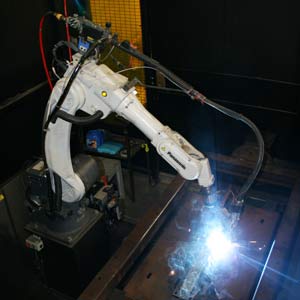
1. There’s more to the payback on a robotic welding system than just speed
2. Parts and product flow need to be consistent
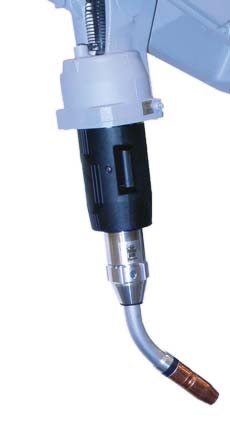
3. The MIG guns and consumables on the robot can impact productivity and profitability

4. Peripherals can help improve the return on investment in a robotic welding operation
5. Having skilled operators with proper training to oversee the robotic weld cell is critical
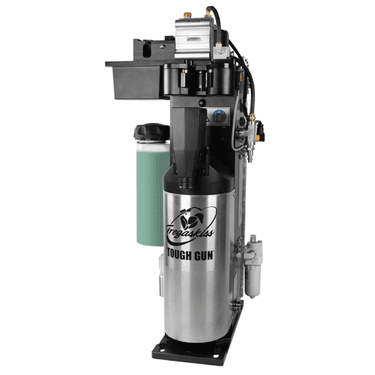
The Value of Comfort: Gaining Productivity with the Right Welding Gun
The Value of Comfort: Gaining Productivity with the Right Welding Gun
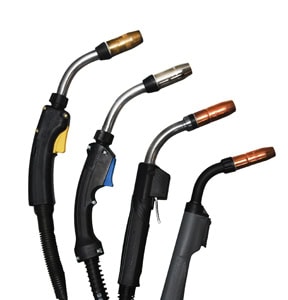
Minimize fatigue with the right handle
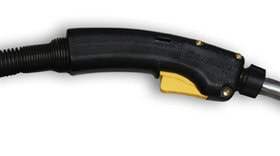
Keep power cables short, small

Reduce strain with the right neck
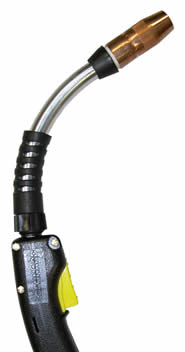
Staying comfortable by staying cool
Welding contractor shares benefits of Bernard Dura-Flux Self-Shielded Flux-Cored Gun | Customer Testimonial
Welding contractor shares benefits of Bernard® Dura-Flux™ Self-Shielded Flux-Cored Gun
FAQs About Robotic Peripherals Answered
FAQs About Robotic Peripherals Answered

Why is a nozzle cleaning station important?
What’s the benefit of adding an anti-spatter sprayer to a nozzle cleaning station?

How do neck inspection fixtures work?
How can peripherals help protect against collisions?
Hybrid Robotic MIG Gun Adds to Automation Benefits for Phoenix-Based Company
TOUGH GUN I.C.E. Robotic MIG Gun Adds to Automation Benefits for Phoenix-Based Company
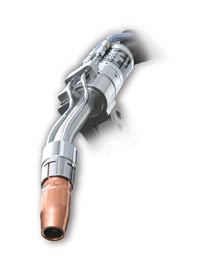
Investing in Automation
Choosing the Right Robotic MIG Gun
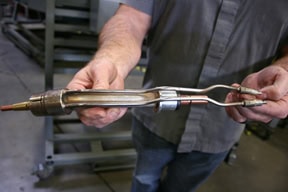
the company’s TOUGH GUN I.C.E. robotic MIG gun. The external water lines circulate coolant to the front-end consumables, helping them run cooler and last longer.Answers to Frequently Asked Questions About Welding Automation
From the Contact Tip to the Robot: Answers to Frequently Asked Questions About Welding Automation
What are the best applications for a robotic welding system?
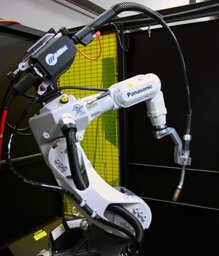
Is it better to use fixed automation or a robot?
Who is the best candidate to operate a robotic welding system?
Can an air-cooled robotic MIG gun be used instead of a water-cooled gun?
What are the best consumables to use?
What is the benefit of touch sensing?
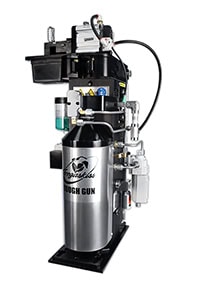
Is it necessary to add peripherals to a robotic welding system?
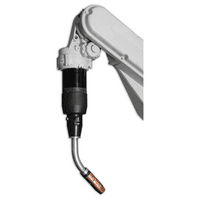
What type of payback can be expected from a robotic welding system?
Miller Welding and Machine Turns to Bernard for MIG Guns and Consumables
Partners In Growth
Miller Welding and Machine Turns to Bernard for MIG Guns and Consumables
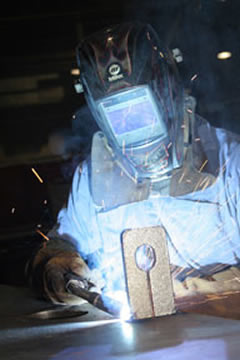
From Humble Beginnings
Inventory Management
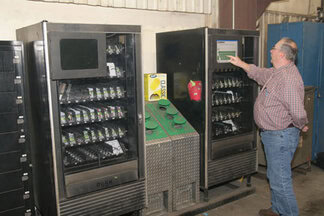
Reduced Downtime, Improved Quality
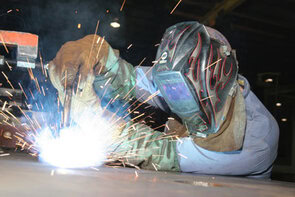
Guns that Stick
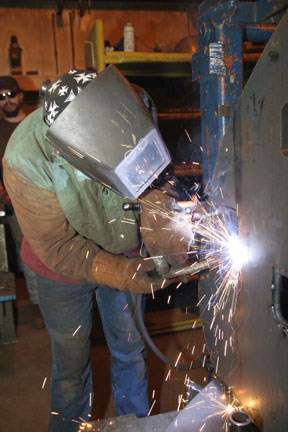
Bernard Consumables and MIG Guns Help OEM Fabricators Standardize Their Operations
Profiting In Lean Times
Bernard Consumables and MIG Guns Help OEM Fabricators Standardize Their Operations
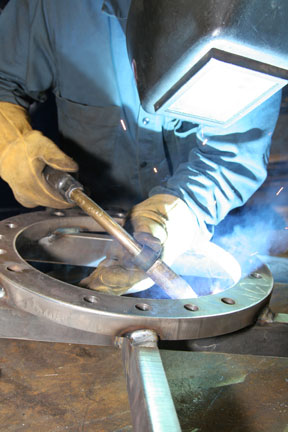
A Pro-Active Approach
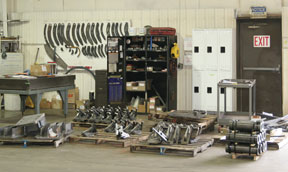
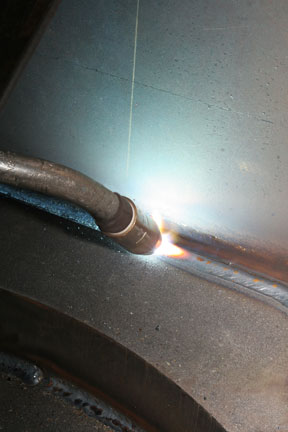
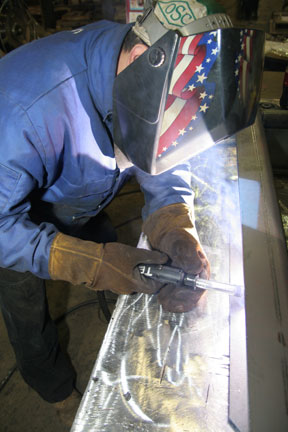
A Guide to Troubleshooting Common GMAW Gun and Consumable Problems
Don’t Let Your Gun and Consumables Get in the Way of Your Welds
A Guide to Troubleshooting Common GMAW Gun and Consumable Problems
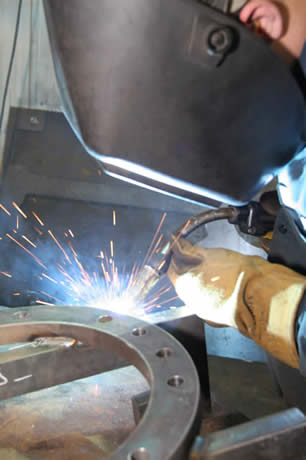
Wire Does Not Feed
Contact Tip Burnback
Erratic wire feeding
Improper Drive Roll Size & Tension

Short contact tip life
Other Causes of Short Contact Tip Life
Erratic Arc
Extreme Spatter
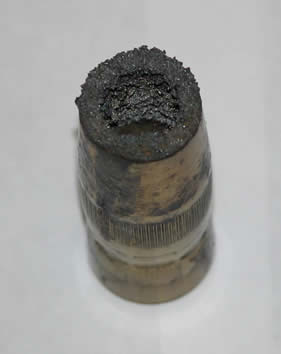
Porosity In Weld
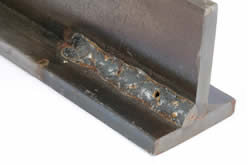
Gun Running Hot
Simple Tips for Getting the Most from Your MIG Equipment
Simple Tips for Getting the Most from Your MIG Equipment
Maintain Your MIG Gun

Feeder Connection
Cable
Liner

Handle and Trigger
Neck
Consumables

Nozzles

Contact Tip
Understanding MIG Gun Liners
Understanding MIG Gun Liners

Optimizing the Performance of Your MIG Gun Liners
Buy quality:
Choose the right size:
Don’t overdo it:

Regular maintenance:
Troubleshooting Your MIG Gun Liners

Poor wire feeding:
Birdnesting:
Electrical short:
Making Your MIG Gun Consumables Last
Making Your MIG Gun Consumables Last
Simple Ways to Save Money, Improve Weld Quality and Minimize Downtime

be certain that the connections between the retaining head, contact tip and nozzle are secure.
In the MIG welding process, the nozzle directs the shielding gas around the welding wire and arc to the weld puddle. Its purpose is to protect the weld from the atmosphere and/or other contaminants that can cause weld defects, such as porosity, that can lead to costly rework. Unfortunately, due to its proximity to the weld puddle, the nozzle is a common source of spatter accumulation that can obstruct that shielding gas flow.Start at the Beginning
Keep Connected


Line Up
A Final Word
Which Semi-Automatic MIG Gun is Right for the Job?
Light- or Heavy-Duty? Which Semi-Automatic MIG Gun is Right for the Job?

On the Lighter Side
Finally, some unicables on light-duty MIG guns have crimped connections and may not be able to be repaired. If a crimped cable becomes damaged, the cable or possibly the entire gun may need to be replaced.For the Tougher Jobs
Parting Thoughts
Good GMAW Welds Begin with Good, Well-Maintained Equipment
Good GMAW Welds Begin with Good, Well-Maintained Equipment

Maintaining Your Equipment

Troubleshooting

The Road to Welding Automation
The Road to Welding Automation
Why and When to Take the Journey
What’s the Benefit?
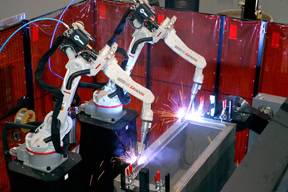
quality, increase productivity and help address the shortage of
skilled welders.Repeat That?
Robotics or Fixed Automation?
Ready to Automate?
Learn How Peripherals Can Maximize Your Robotic Welding Performance
Don’t Be Marginalized
Learn How Peripherals Can Maximize Your Robotic Welding Performance
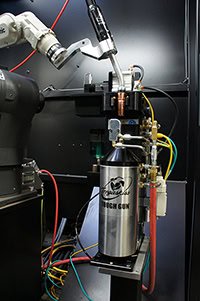
Get a Grip
Making the Cut
Inspected and Ready to Weld

of an impact by signaling to the robot
to stop weldingCleaned, Sprayed and Spatter-Free
No Peripheral Decision
Is Automation Right for Your Welding Operation
Is Automation Right for Your Welding Operation?
Considerations to Make Before Investing
Automation Advantages
Parts Should Be Easy to Weld
Justify Automated Solutions with High Part Volume
Evaluating the Facility
Supervision of the Automated Cell
Prior Planning Prevents Poor Performance
Additional Information: Fixed Automation Versus Fully Automated
5 Tips for Improving Robotic Welding
5 Tips for Improving Robotic Welding
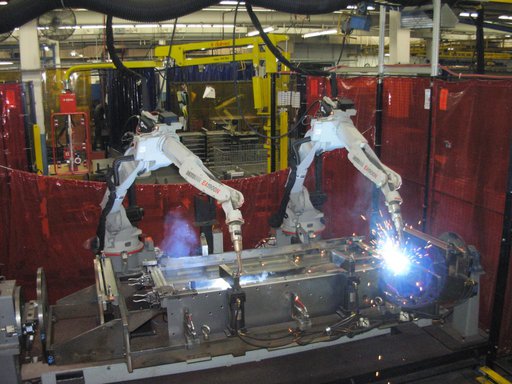
1. Select the Right Wire
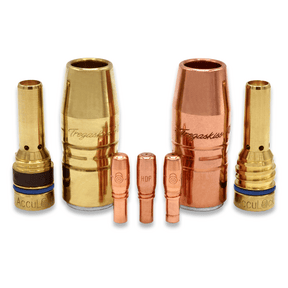
2. Choose the Right Consumables
3. Consider a Front-Load Liner
4. Select the Right Filler Metal Package
5. Select the Right MIG Gun
Additional Resources
Automated Intelligence: Deciding Whether Automation is Right For You
Automated Intelligence:
Deciding Whether Automation is Right For You
1. Why Automate?
2. Payback
3. Whether to Automate
4. Your Automation Options
5. Automation Componentry
6. Planning for the Future
7. Throughout the Journey
Final Thoughts
Simple Ways to Protect Your Robotic MIG Gun
Simple Ways to Protect Your Robotic MIG Gun…
and Your Overall Investment in Automation

The Who, Why and Whens of PM
Getting Down to the Specifics
schedule a liner replacement as required. Replacing it prior to a failure prevents unplanned downtime to remedy wire feeding or quality problems later.Parting Thoughts on PM
Choosing the Right Robotic Gun for MIG Applications
Choosing the Right Robotic Gun for MIG Welding Applications
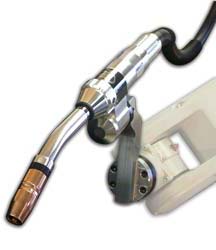
including an air-cooled model (as shown
here), can help ensure good weld quality,
and reduce equipment and maintenance cost — factors that lead to a good return on investment and greater productivity.Staying Cool with Air-Cooled Technology
Just Add Water
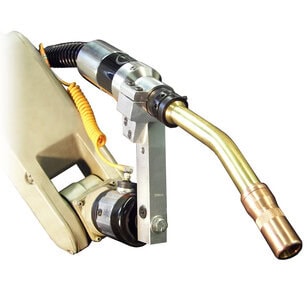
offer high-amperage capacity for applications
requiring prolonged periods of welding.An Option in Between

offer the durability of an air-cooled
model gun with the greater cooling
capacity of a water-cooled one,
making them an ideal fit for welding
multiple thicknesses of materials.Protecting the Assets
Understanding MIG Welding Nozzles
Understanding MIG Welding Nozzles

insert, as shown in this cut-away, can help extend
the life of the consumable. The brass insert,
in particular, helps maintain the inner diameter
of the nozzle and reduce wear.Selecting the Right Shape of Nozzle
A Simple Guide to Selecting the Proper Nozzle
Welding Application Nozzles Considerations Welding Current
High Heat
Limited Weld Access
Heavy Spatter Generation
Using Nozzle Cleaning Stations
Selecting the Best Material

build-up, as seen here, and cleaning it
properly can help extend the life of the
consumable. Adding anti-spatter can also
help prevent build-up.Proper Storage, Handling and Maintenance
Storage
Handling
Maintenance
Handling, Installing, and Maintaining GMAW Consumables
Handling, Installing, and Maintaining GMAW Consumables
Tips to Follow and Pitfalls to Avoid
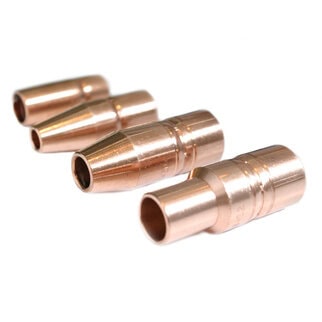
properly can minimize downtime and costs.The Heat Factor
Using Anti-Spatter Solution
Storing and Handling Consumables
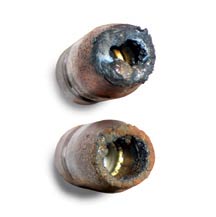
spatter buildup shown hereEstablishing and Maintaining Good Connections
Trimming Liners Correctly
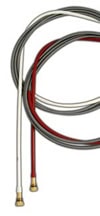
manufacturer’s recommendation
for proper trimming and
installation instructions. Also
be sure to wear gloves when
handling the liner to avoid
contaminating it.Minding the Contact Tip Position and Nozzle Size
Things to Remember

